Apollo 17 entered lunar orbit on Dec. 10, 1972. The next day, astronauts Eugene A. Cernan and Harrison H. “Jack” Schmitt, the first trained geologist to travel to the Moon, separated their Lunar Module (LM) Challenger from the Command Module (CM) America, with Ronald E. Evans aboard, who remained in orbit. Cernan and Schmitt brought Challenger to a soft-landing at the Taurus-Littrow landing site and conducted three surface excursions totaling 22 hours, driving the third Lunar Roving Vehicle for 22.2 miles. They deployed a set of instruments that operated long after they departed and collected 254 pounds of rock and soil samples. During this time, Evans conducted observations of the lunar surface from orbit. After their 75-hour stay, Cernan and Schmitt prepared to rejoin Evans in orbit.
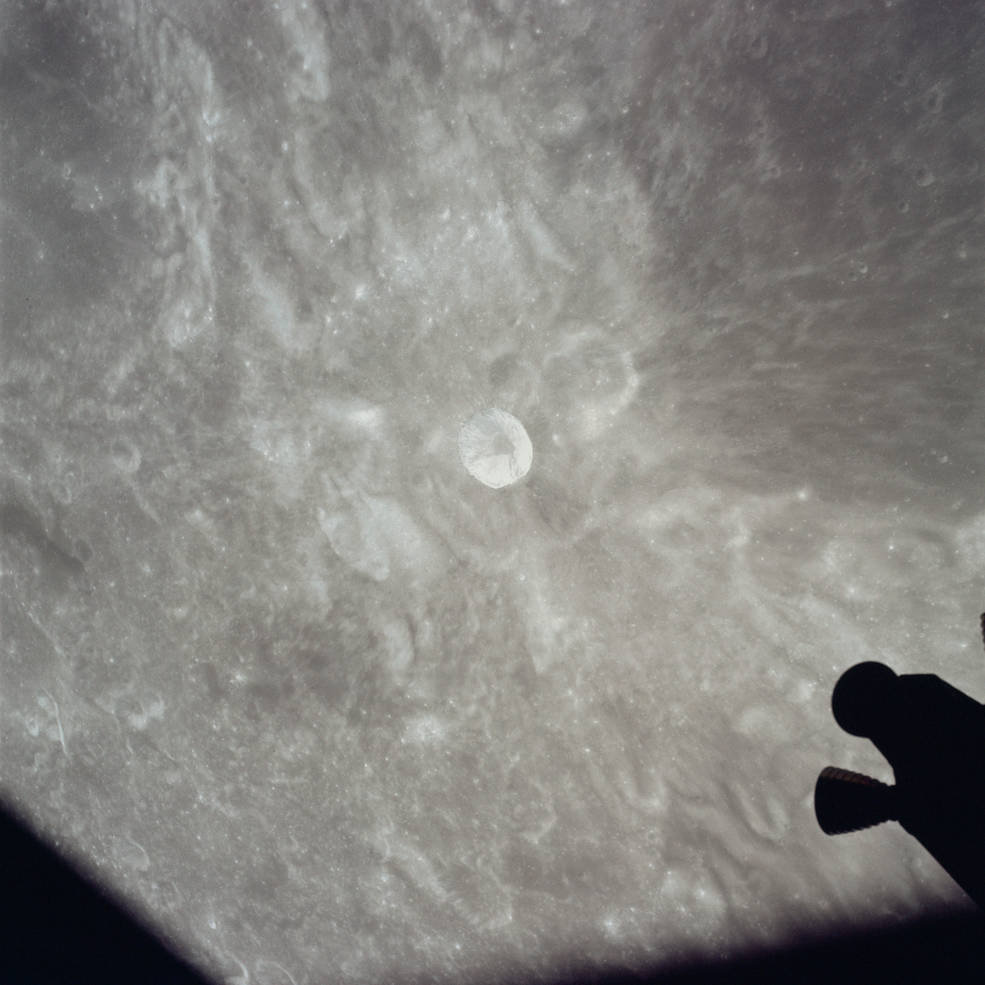
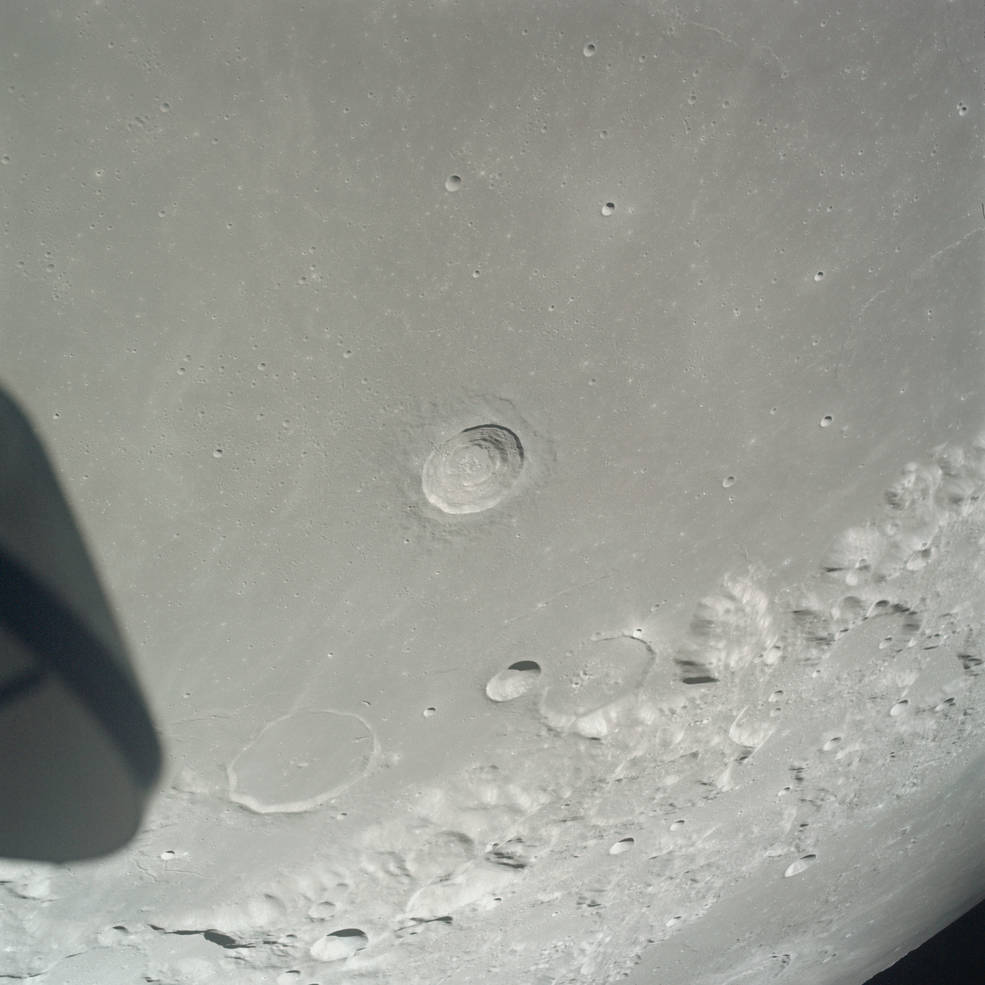
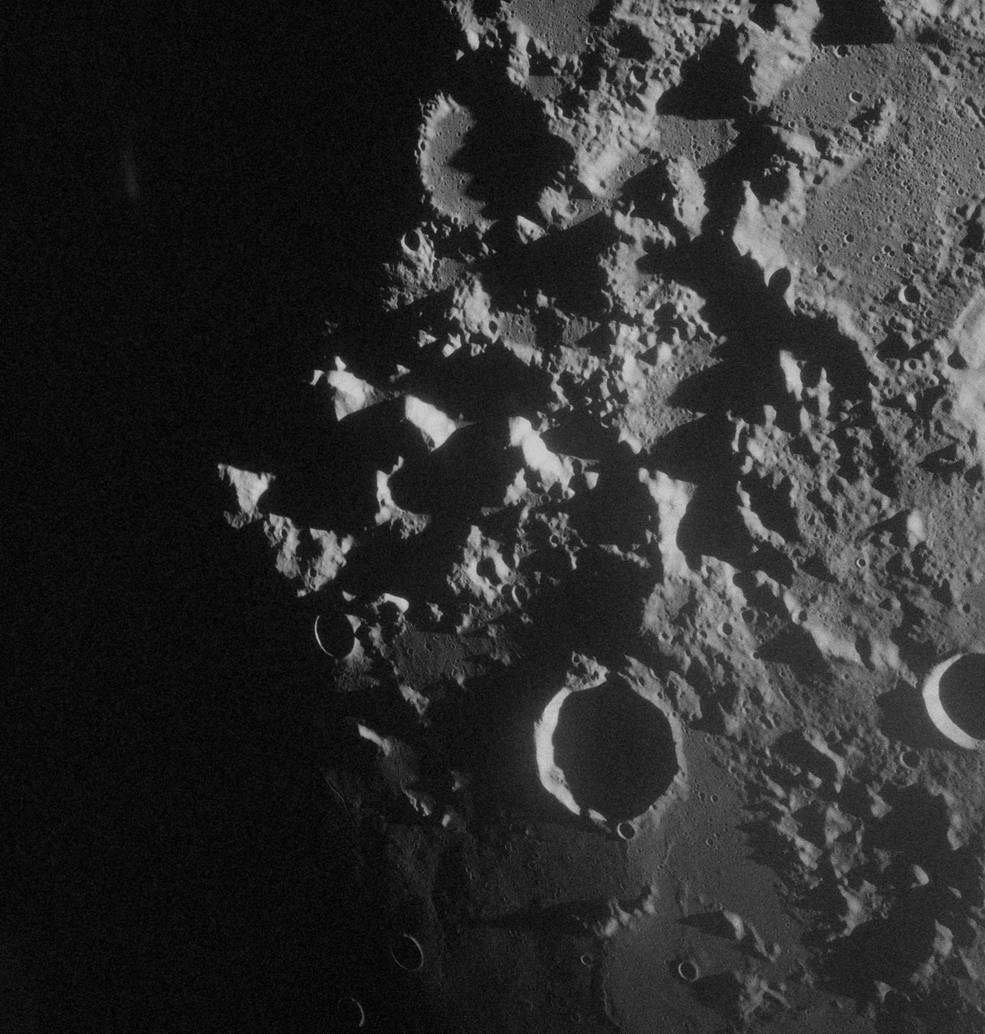
Photographs taken during Apollo 17’s first lunar orbit. Left: Image of a fresh crater. Middle: View of Crater Picard at center and the southeast rim of Mare Crisium. Right: Littrow Crater at the lunar terminator.
Following the Dec. 7, 1972, launch from NASA’s Kennedy Space Center in Florida, Apollo 17’s uneventful translunar coast lasted 83 hours. On the astronauts’ fifth day in space, their spacecraft’s trajectory took them past the leading edge of the Moon, and as they disappeared behind it, as expected all contact with the Mission Control Center (MCC) at the Manned Spacecraft Center, now NASA’s Johnson Space Center in Houston, temporarily stopped. Thirty minutes later, the Service Propulsion System (SPS) engine fired for 6 minutes 33 seconds for the Lunar Orbital Insertion (LOI) burn to drop them into an elliptical 196-by-60-mile lunar orbit. Cernan became the second person (after John W. Young) to orbit the Moon on two separate missions, his first being Apollo 10 in May 1969. As they reappeared from behind the Moon, he radioed to MCC, “You can breathe easier, America has arrived on station for the challenge ahead.” Of the LOI burn, Cernan reported, “The SPS burn couldn’t have been more nominal.” From the MCC, C. Gordon Fullerton, capsule communicator (capcom) on Flight Director Gerald D. “Gerry” Griffin’s Gold Team of controllers, replied, “That sounds great, Gene.” Cernan, Evans, and Schmitt described the scenes of the lunar terrain as it passed by beneath them, took a series of photographs, and activated the panoramic camera in the Scientific Instrument Module (SIM) bay in the Service Module.
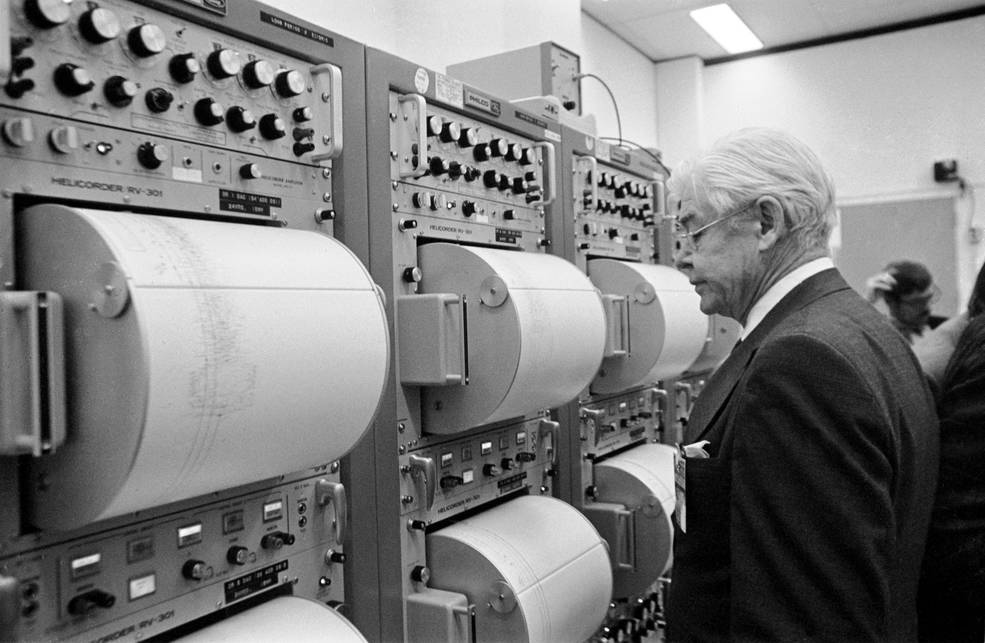
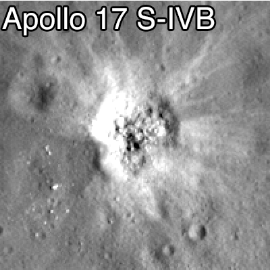
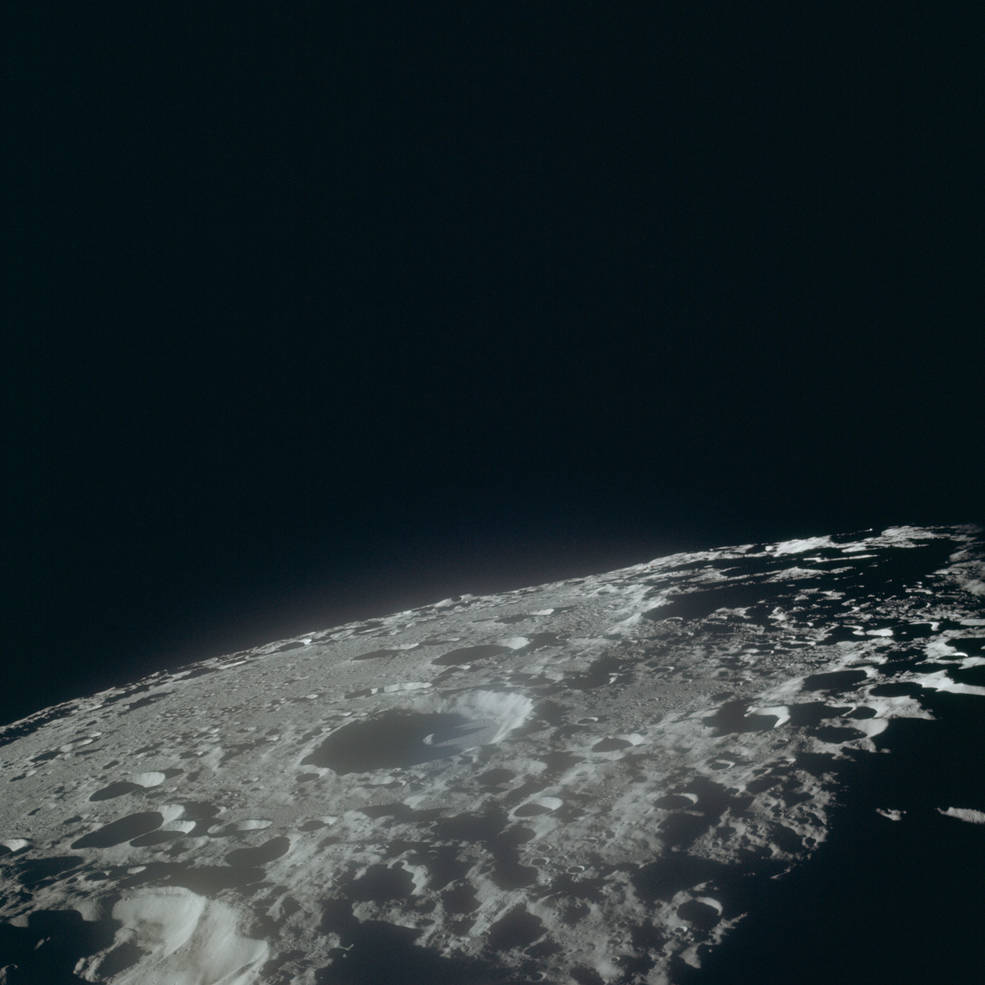
Left: Geophysicist W. Maurice “Doc” Ewing examines seismograph tracings following the impact on the Moon of the Apollo 17 S-IVB third stage. Right: Image of the crater created by the impact of Apollo 17’s S-IVB stage, taken by the Lunar Reconnaissance Orbiter in 2010. Image credit: NASA/GSFC/Arizona State University. Right: Korolev Basin on the lunar farside.
Capcom Fullerton reported to the crew that the Saturn V’s S-IVB third stage impacted on the Moon as planned, “the S-IVB crunched in on time, and it’s been ringing the ALSEP seismometers like mad for some time now,” referring to the Apollo Lunar Science Experiment Package instruments deployed by the Apollo 12, 14, 15, and 16 crews. As they continued on their first pass across the front side of the Moon, the astronauts kept up a steady commentary about the lunar terrain below them, much of it viewed by Earthshine, or illumination provided by light reflected from the Earth. They continued their photography of lunar landmarks as they went behind the Moon to complete their first orbit. By the time they came around the Moon’s front side on their second orbit, astronaut Robert F. Overmyer had taken over as the capcom in MCC, as part of Flight Director M.P. “Pete” Frank’s Orange Team of controllers. The astronauts maneuvered their spacecraft into the proper attitude for the Descent Orbit Insertion (DOI) burn that they completed while behind the Moon to begin their third orbit. The 22-second burn with the Service Propulsion System (SPS) engine changed their orbit to 68 miles by 16.7 miles. When Apollo 17 regained contact with Mission Control, Cernan radioed that “the burn was good on all counts.” Overmyer replied, “Okay, America; sounds great.” With their orbit lowered, Cernan jokingly added, “We’re getting back down among us where us plain folks belong.” The lower descent orbit provided additional fuel for the Lunar Module for extra hover time during the descent and landing to the surface. For the rest of the day, the astronauts continued taking photographs of the Moon, and with the spacecraft’s low point over the landing site, they had the best view of it until they began their descent. During their fifth orbit, the crew began a sleep period.
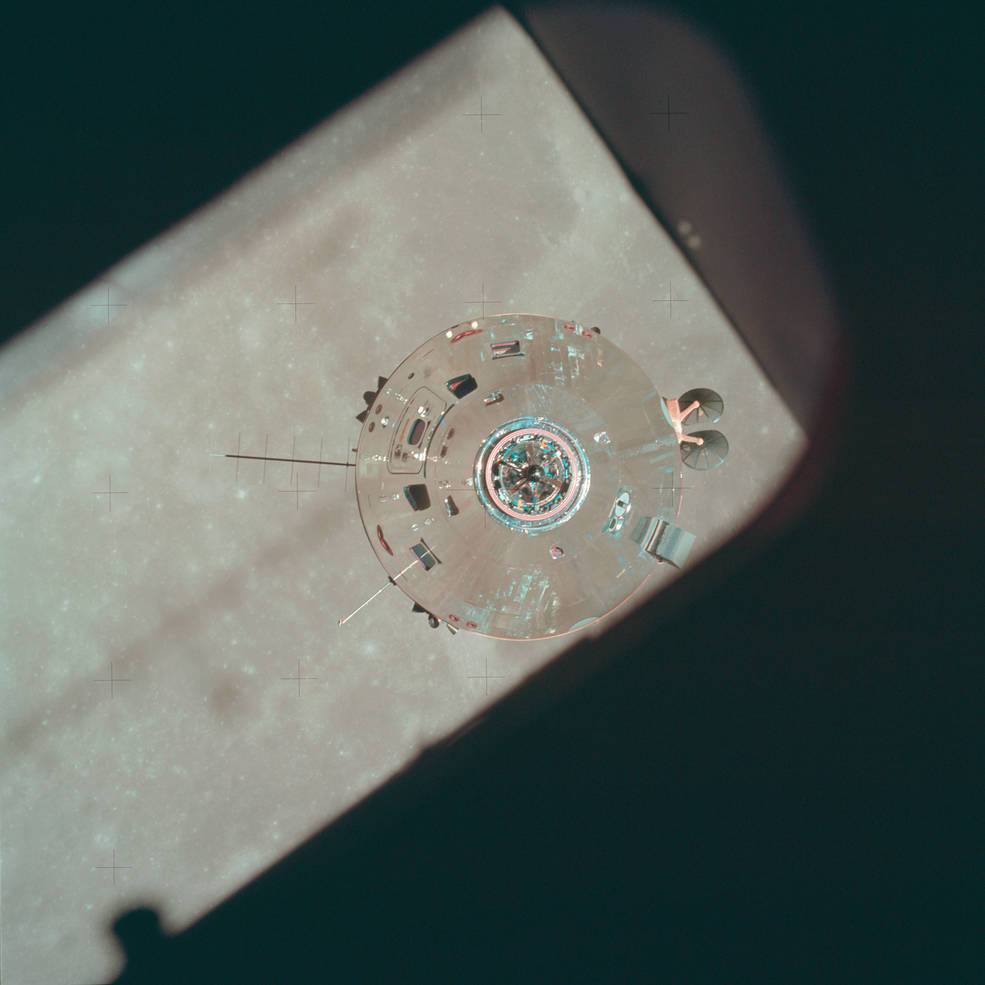
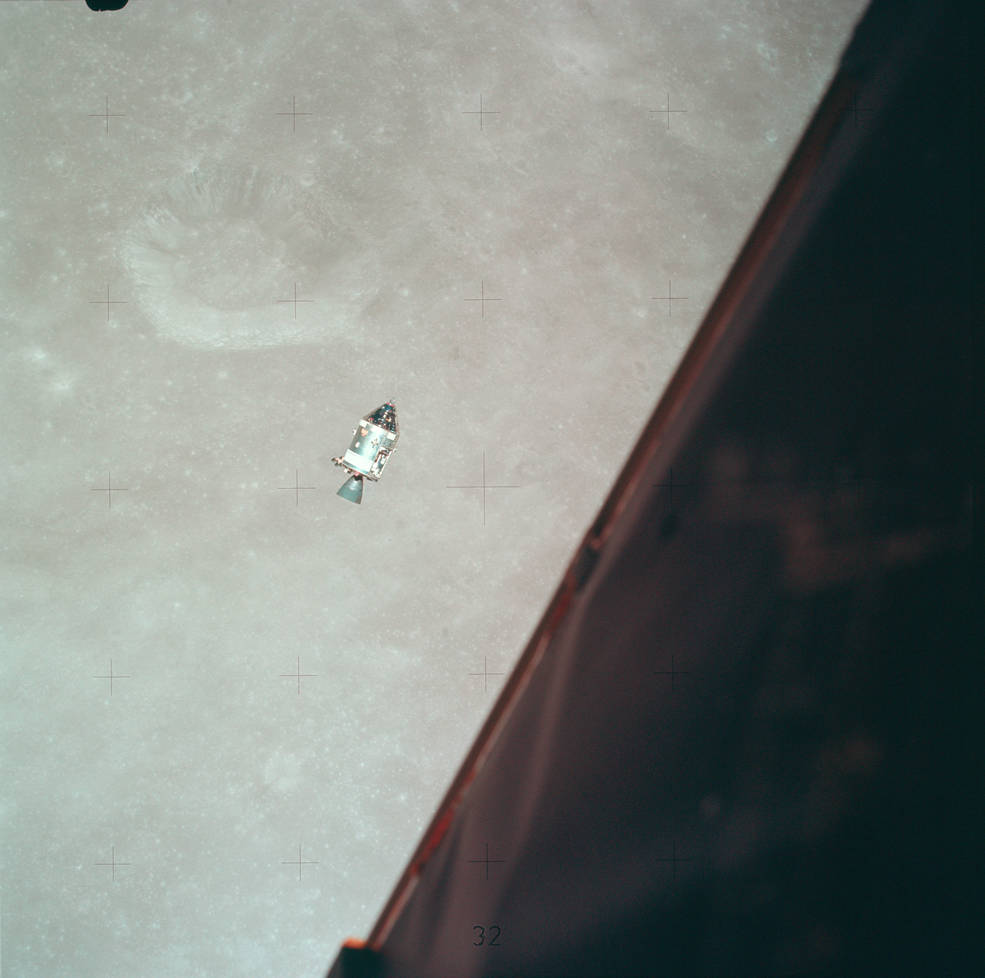
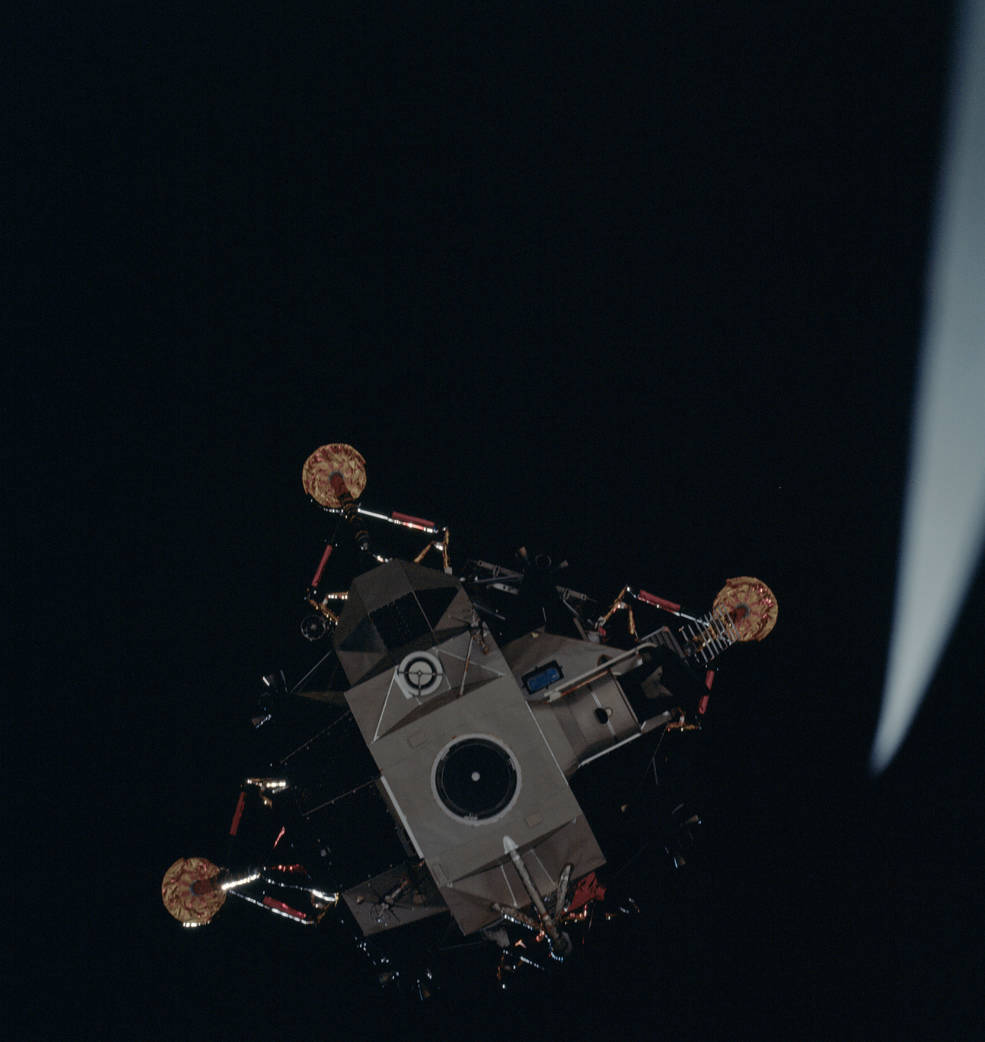
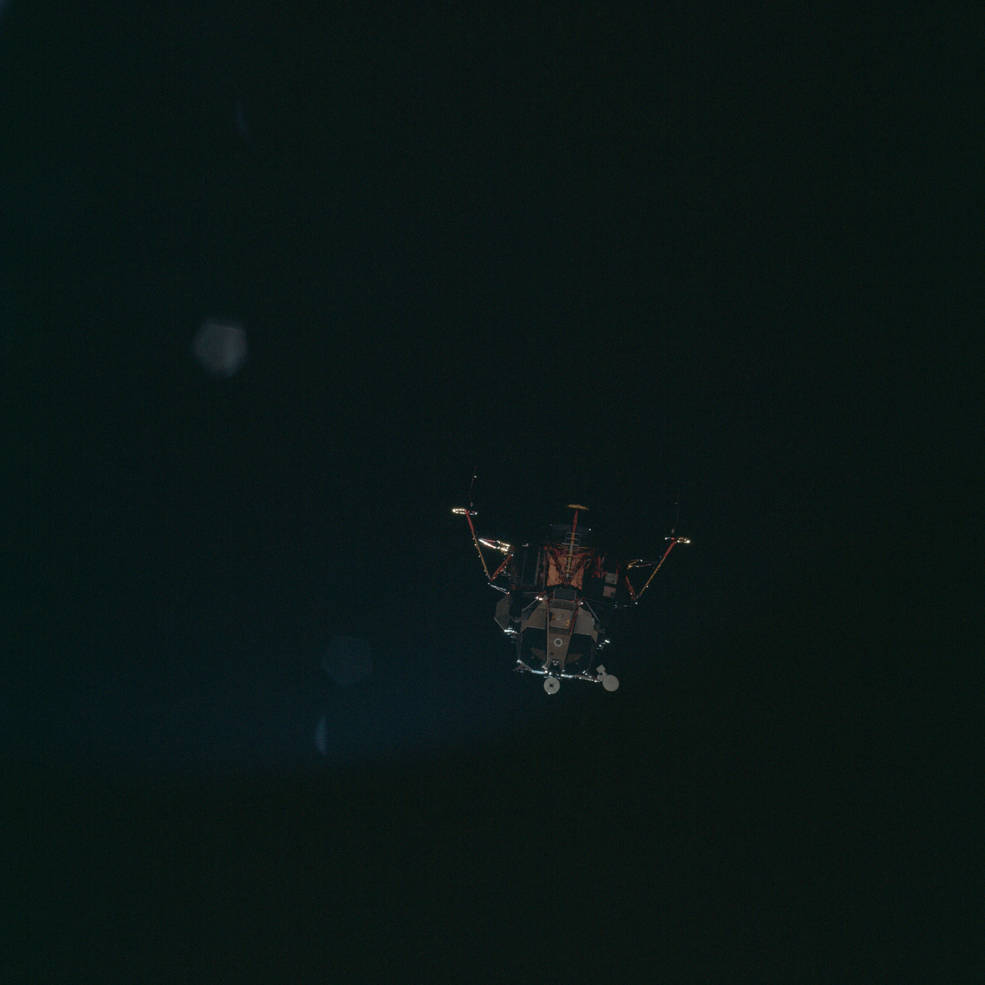
Left and middle left: Two images of the Command Module (CM) America taken from the Lunar Module (LM) Challenger shortly after undocking in lunar orbit. Middle right and right: Two views of Challenger taken from America shortly after undocking.
The next day, landing day, during the astronaut’s ninth orbit around the Moon, Mission Control awaked them with the John Denver version of Steve Goodman’s song, “The City of New Orleans.” Ten minutes later, the spacecraft went behind the Moon, and by the time it reappeared, the astronauts had already finished breakfast and proceeded with preparations to don their spacesuits and open the hatches to the LM. Cernan and Schmitt transferred into the LM and its activation and checkout proceeded without incident. By the 11th orbit, Evans had closed the last hatch on the CM side in preparation for the undocking that took place on the Moon’s farside at the start of the 12th orbit. For the next hour and a half, the crews visually inspected each other’s spacecraft and found everything in working order. Evans fired the SPS engine for 3.8 seconds to circularize his spacecraft’s orbit at 69 miles, better suited for his science observations. Cernan and Schmitt fired the LM’s descent stage engine for 21.5 seconds to lower the low point of their orbit to 7 miles. On the 13th orbit, the LM began the powered descent maneuver, a 725-second burn of the descent engine. With Fullerton at the capcom console, Cernan and Schmitt began their descent to the surface of the Moon. For the first 26 seconds of the burn, the DPS engine fired at 10% of its rated thrust level, then throttled up to full power. Initially, the LM flew with its engine and landing legs in the direction of flight, with the astronauts flying on their backs. At an altitude of 8,000 feet, the LM performed the pitchover maneuver to a more vertical attitude, and Cernan and Schmitt caught sight of their landing zone. An excited Cernan radioed, “And there it is, Houston. There’s Camelot (Crater)!” referring to one of the landmarks just beyond their landing zone. Schmitt activated a motion picture camera mounted in the window that captured the descent and landing. At 5,000 feet, Cernan and Schmitt received the “Go for landing” call from Fullerton, and with Schmitt calling out altitudes and descent rates, Cernan guided the LM Challenger to a smooth touchdown, with the least amount of dust of any of the Apollo landings, and with 117 seconds of fuel remaining, the most of any Apollo landing.
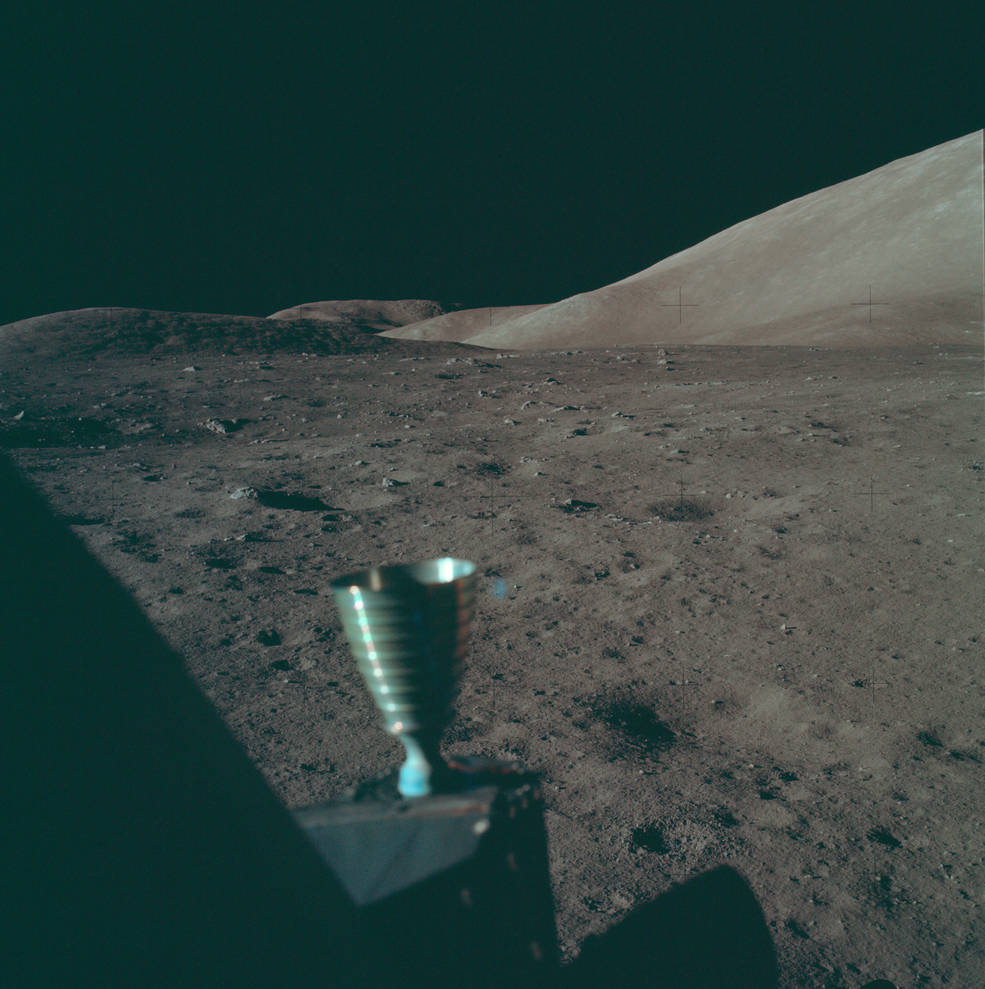
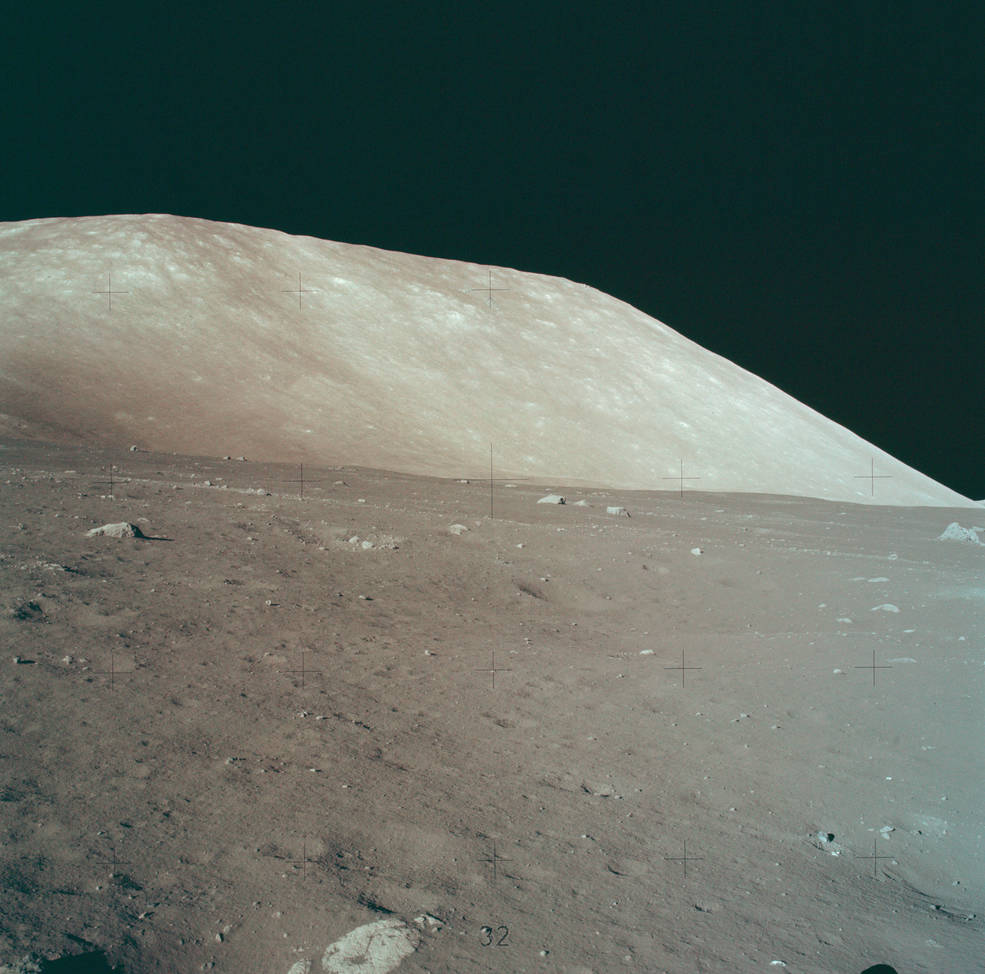
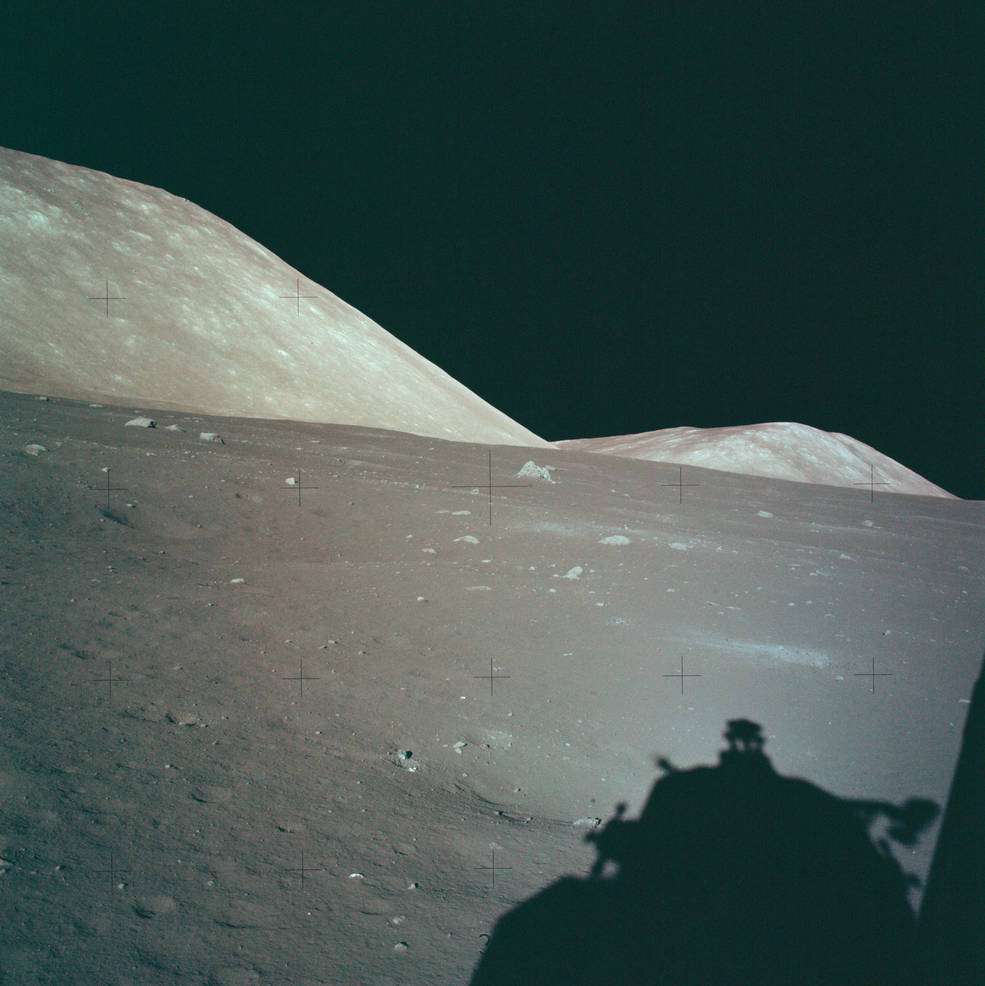
Three views taken from the Lunar Module Challenger’s left side window following landing at the Taurus-Littrow site.
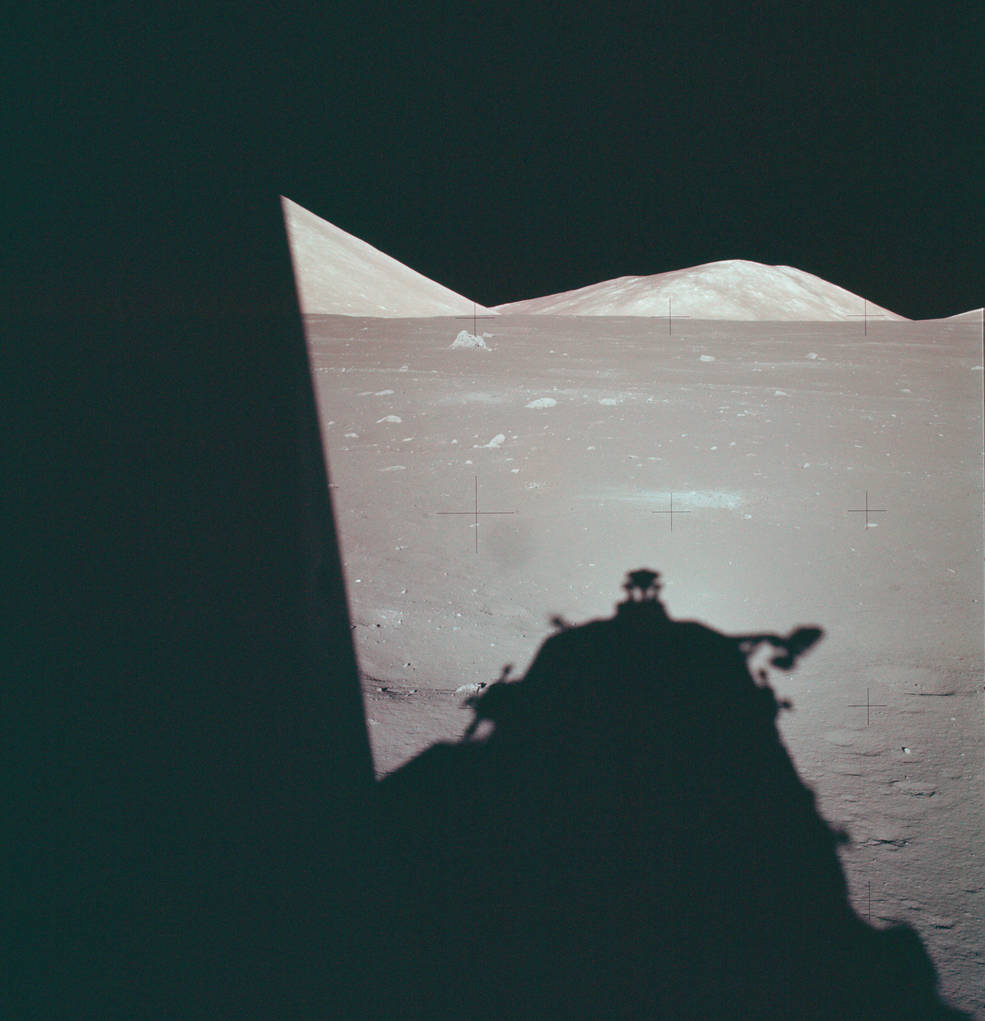
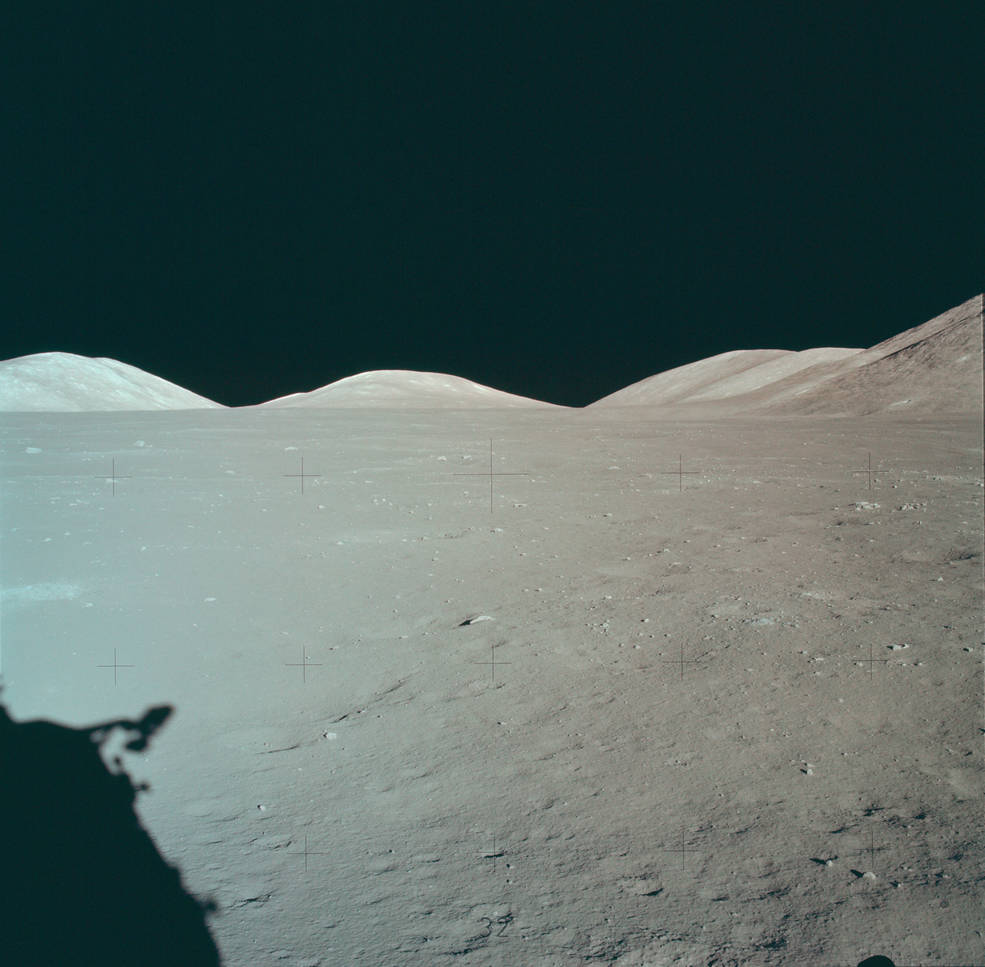
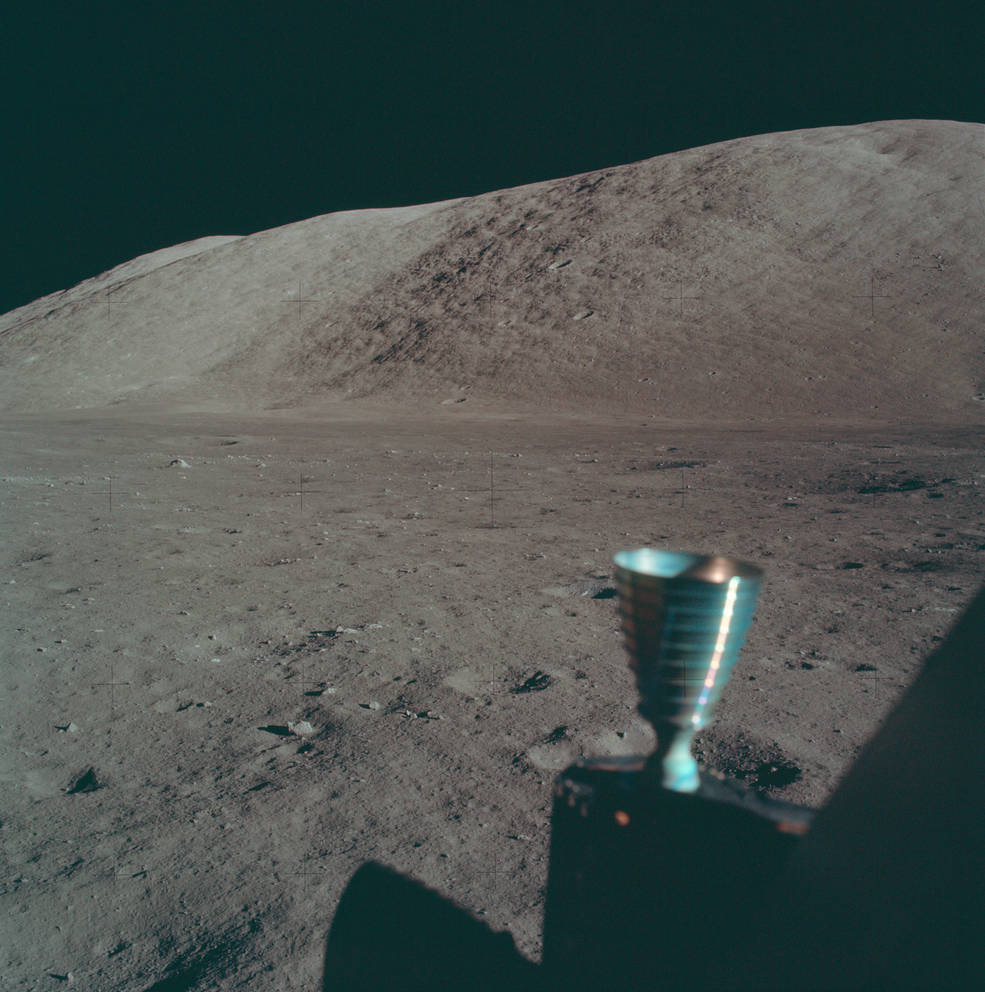
Three views taken from the Lunar Module Challenger’s right side window following landing at the Taurus-Littrow site.
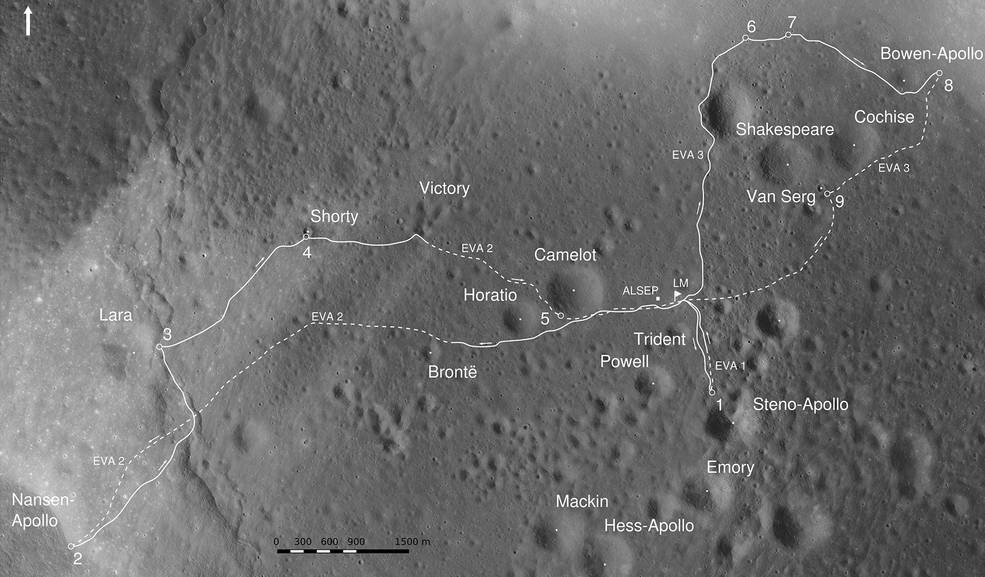
Map of the Apollo 17 landing site showing the three surface traverses.
Cernan radioed to Houston and the world, “Okay Houston, the Challenger has landed!” He and Schmitt did a quick survey of the LM’s systems in case they had to make an emergency departure, and then had a chance to look out the windows, with Cernan exclaiming to Schmitt, “Jack, we are going to have some nice boulders in this area!” Schmitt agreed, “Oh man, look at that rock out there!” Mission Control reviewed the spacecraft’s systems and finding them in satisfactory order, Fullerton gave Cernan and Schmitt the go to stay on the lunar surface. They took survey photographs of their landing area through the LM windows and ate a meal before starting their preparations for the first excursion.
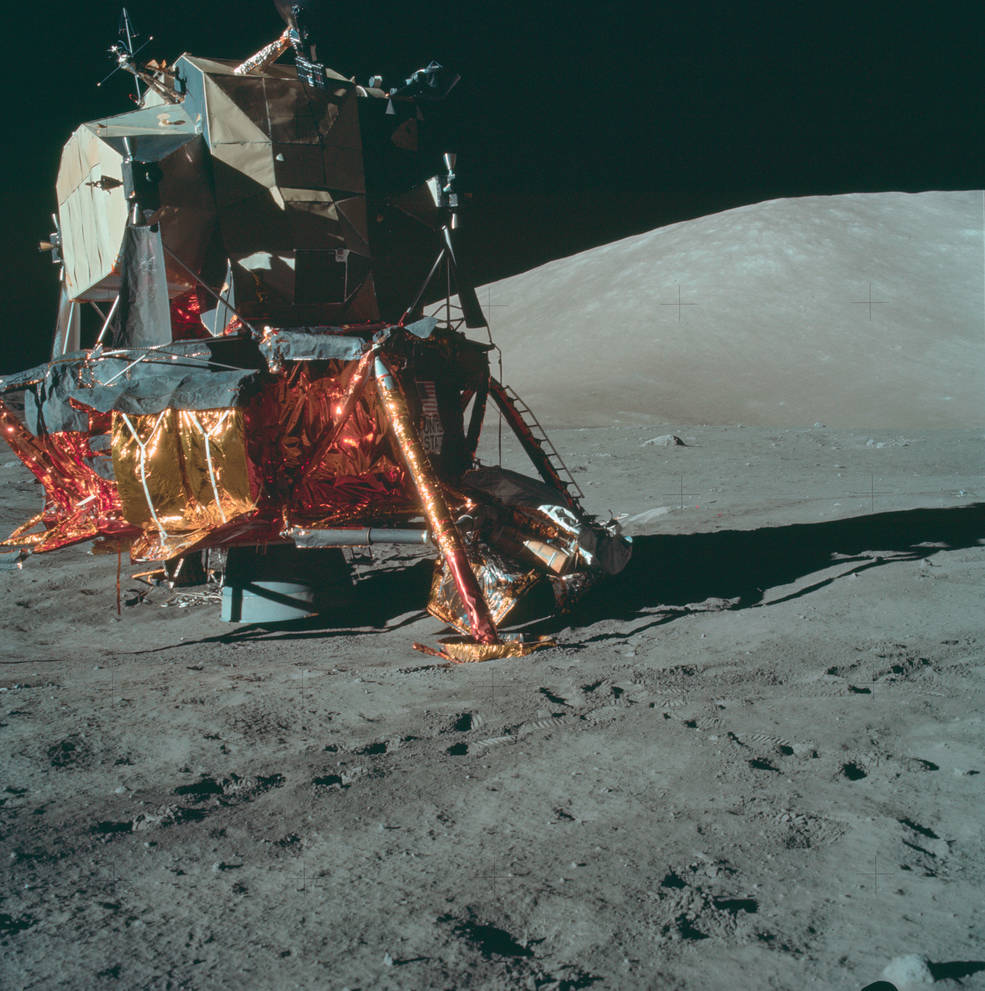
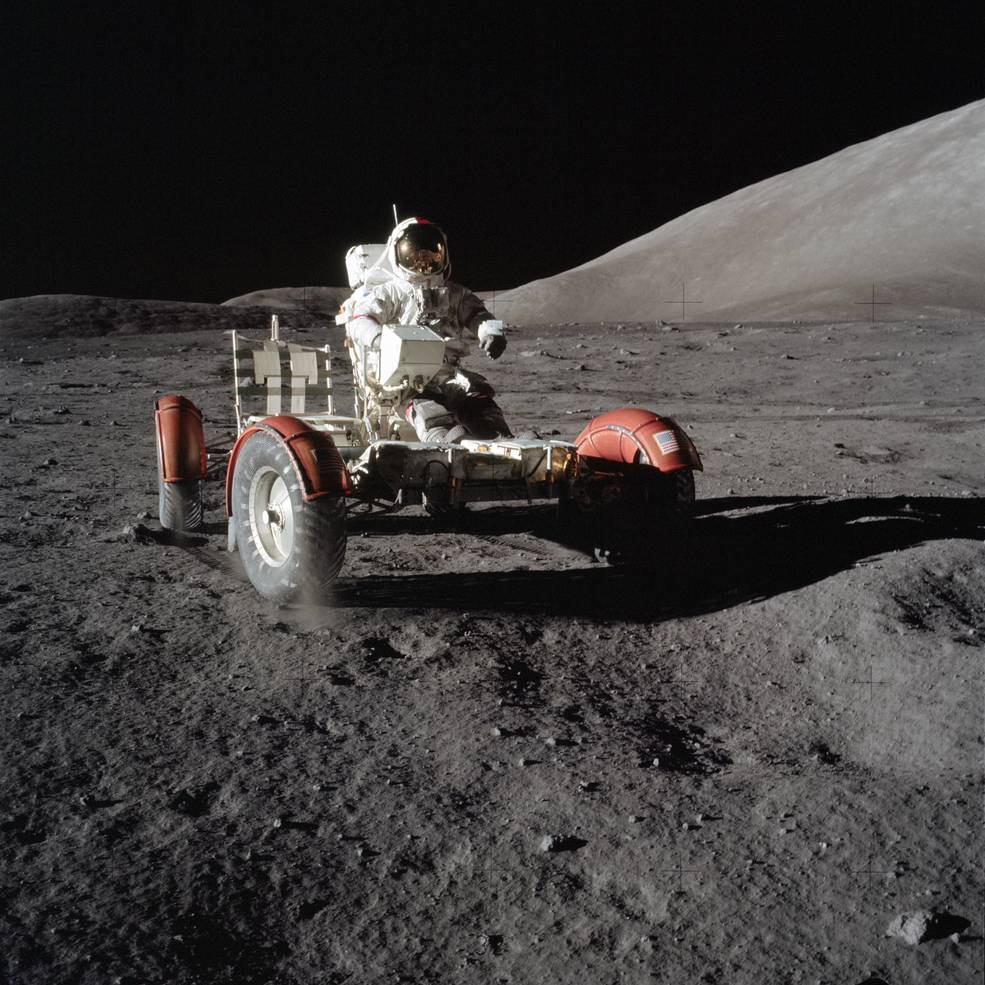
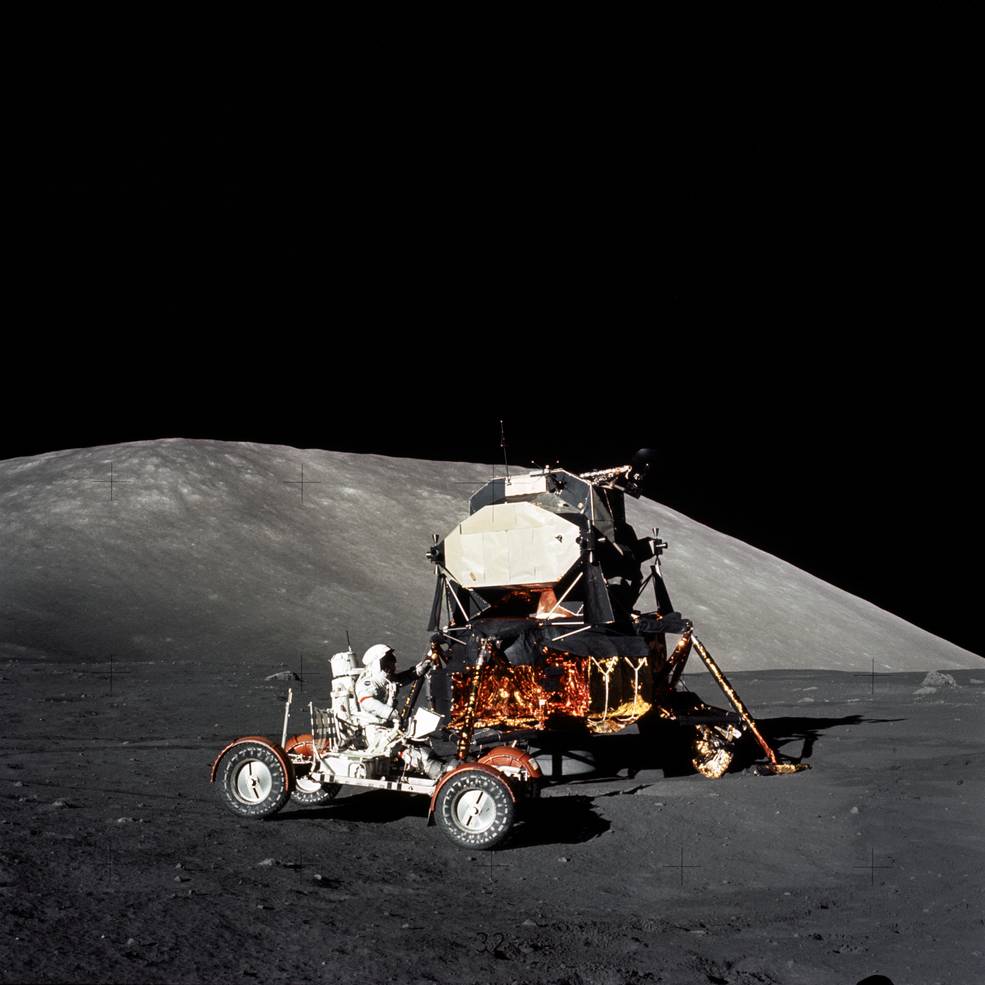
Left: The Lunar Module (LM) Challenger on the surface at the Taurus-Littrow site, during the first surface excursion. Middle: Apollo 17 astronaut Eugene A. Cernan test driving the Lunar Roving Vehicle (LRV) during the first surface excursion. Right: Cernan drives the LRV around the LM.
In MCC, astronaut Robert A.R. Parker took over the capcom console to support Cernan and Schmitt during their time out on the surface. Since they donned their suits prior to undocking, Cernan and Schmitt just had to don the Portable Life Support System (PLSS) backpacks and put their gloves and helmets back on. They depressurized the LM and Cernan opened the side hatch. With Schmitt assisting him in the tight confines of the cabin, Cernan got down on all fours and gingerly backed out the hatch onto the LM’s porch. When Cernan asked Schmitt if he thought he was making progress egressing, Schmitt responded, “I think you’re getting out though, because there’s not as much of you in here as there used to be.” Once on the porch, Cernan pulled on a D-ring that released latches on the Modular Equipment Stowage Assembly (MESA), a table-like platform that swung down 120 degrees from the side of the LM and contained work platforms and tools for the astronauts to work, including stowing rock collections boxes. He used a lanyard to lower an Equipment Transfer Bag (ETB) contained cameras, film cartridges, and other essentials to the surface. Cernan then made his way down the ladder, and once on the footpad, he radioed, “And, Houston, as I step off at the surface at Taurus-Littrow, we’d like to dedicate the first step of Apollo 17 to all those who made it possible.” As Cernan began to acclimate to walking in the one-sixth lunar gravity, Schmitt started his descent to the surface. Once both men had placed boots in the lunar dust, and after giving Schmitt a few minutes to acclimate, the two began the first major task of the spacewalk – the release and deployment of the Rover. Schmitt climbed back up the ladder to pull a lanyard that released the folded up Rover from the side of the LM. Cernan took it for a test drive around the LM, then parked it near the MESA so he and Schmitt could load their gear onto it, and set up the TV camera and the dish-shaped high-gain antenna, providing TV coverage of their activities. Edward I. “Ed” Fendell, known affectionately as “Captain Video,” remotely controlled the TV camera on the Rover from his Instrumentation and Communications Command (INCO) console in MCC during Cernan and Schmitt’s excursions on the surface.
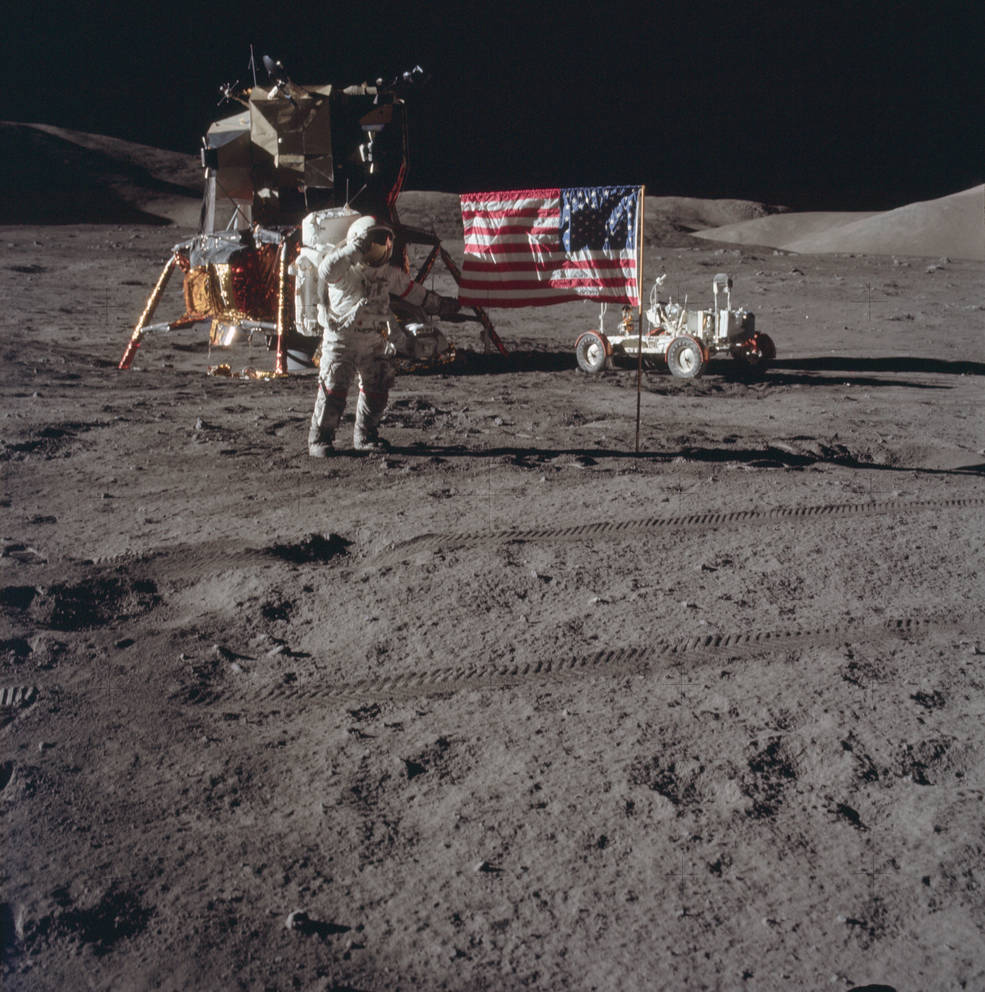
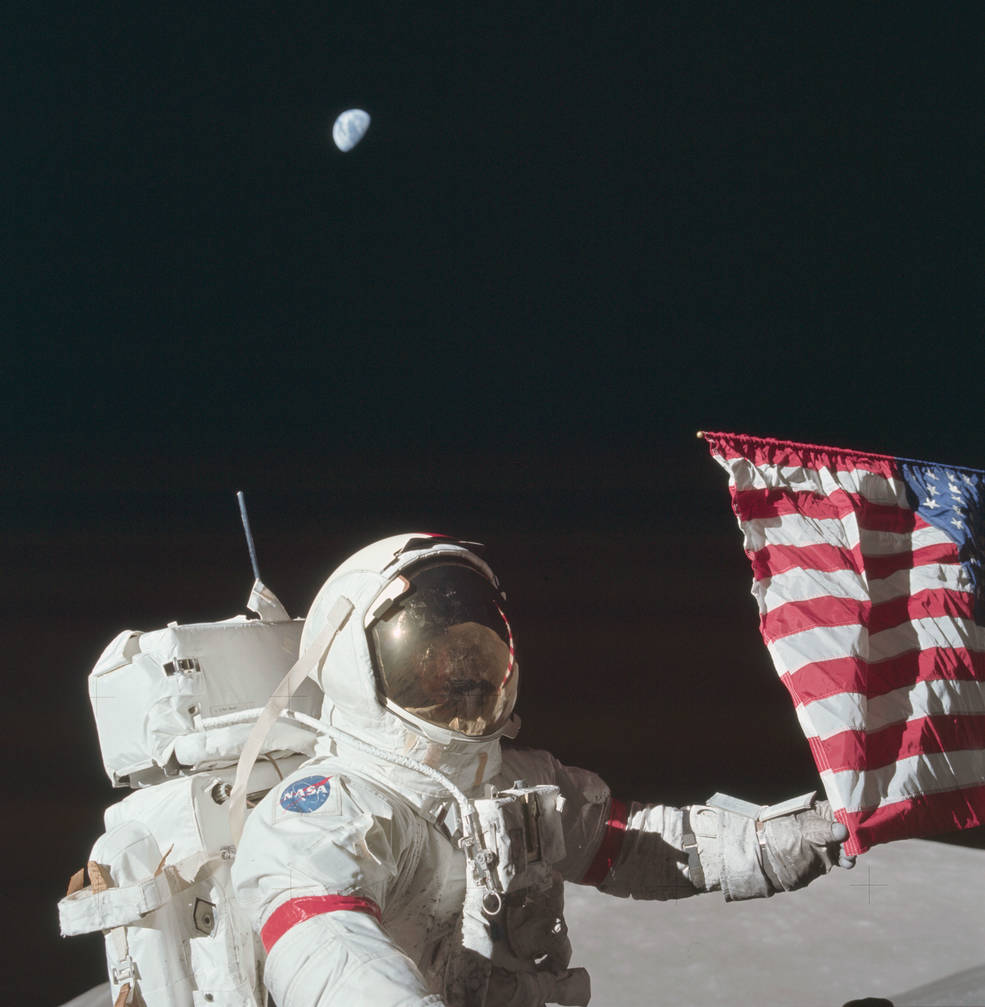
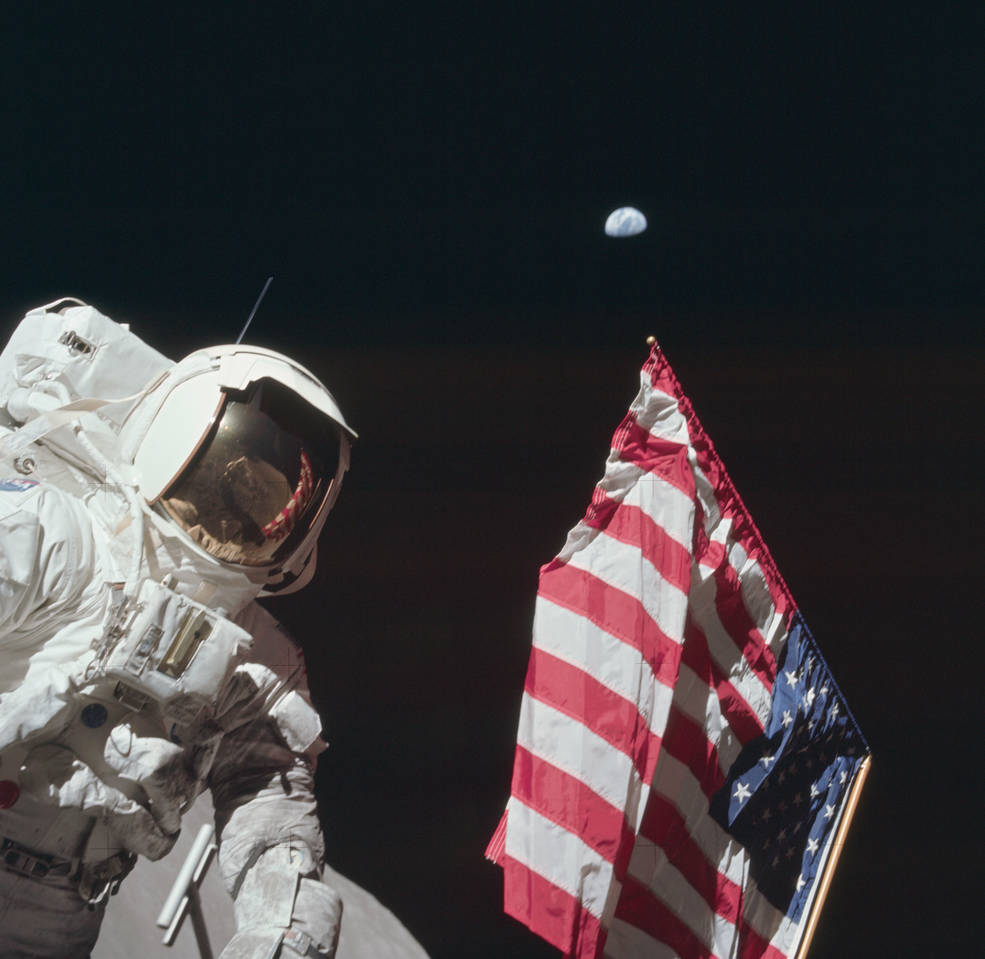
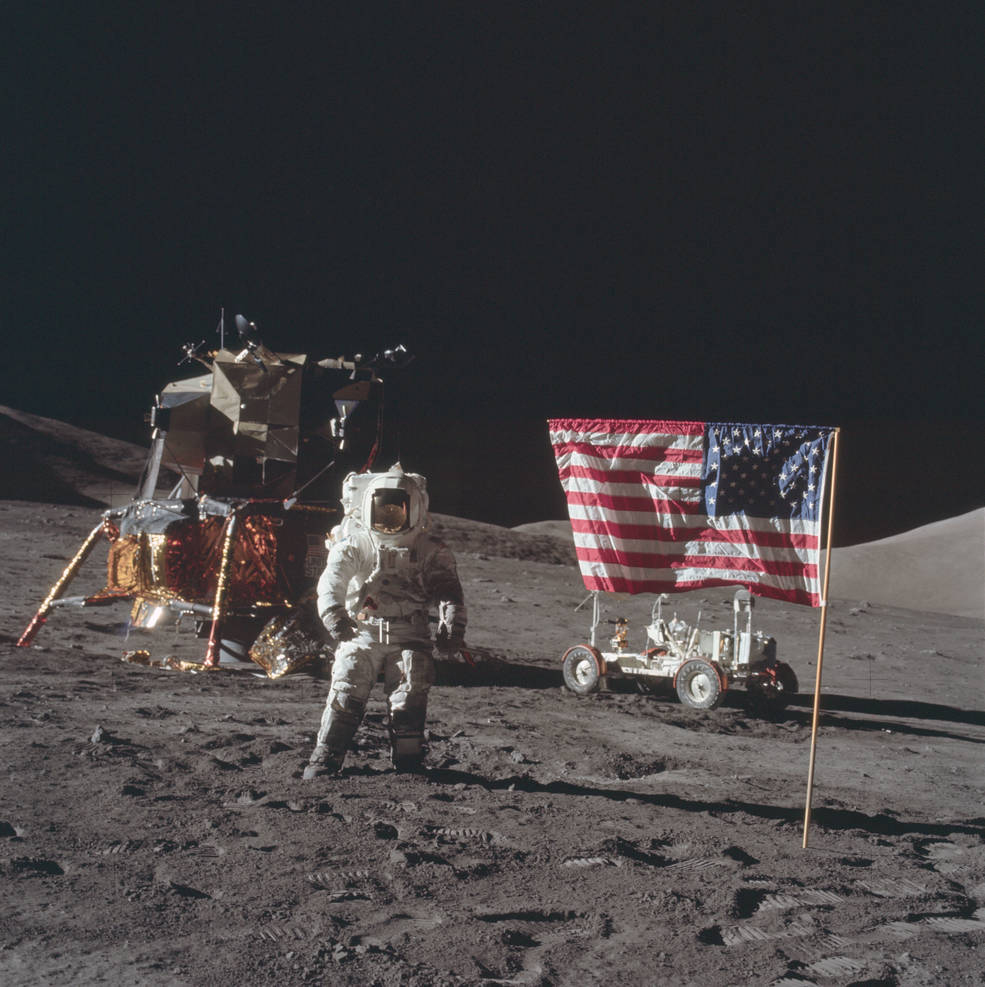
Left and middle left: Apollo 17 astronaut Eugene A. Cernan with the American flag. Middle right and right: Apollo 17 astronaut Harrison H. “Jack” Schmitt with the American flag.
Cernan and Schmitt next deployed the American flag, about 30 feet from the LM. Cernan commented that, “this has got to be one of the most proud moments of my life.” As Schmitt explained to everyone listening, this particular flag had hung in MCC during each of the previous Apollo Moon landing missions. The Apollo 17 astronauts brought another flag that made the roundtrip to the Moon and about a year after the mission the presented it to hang in MCC.
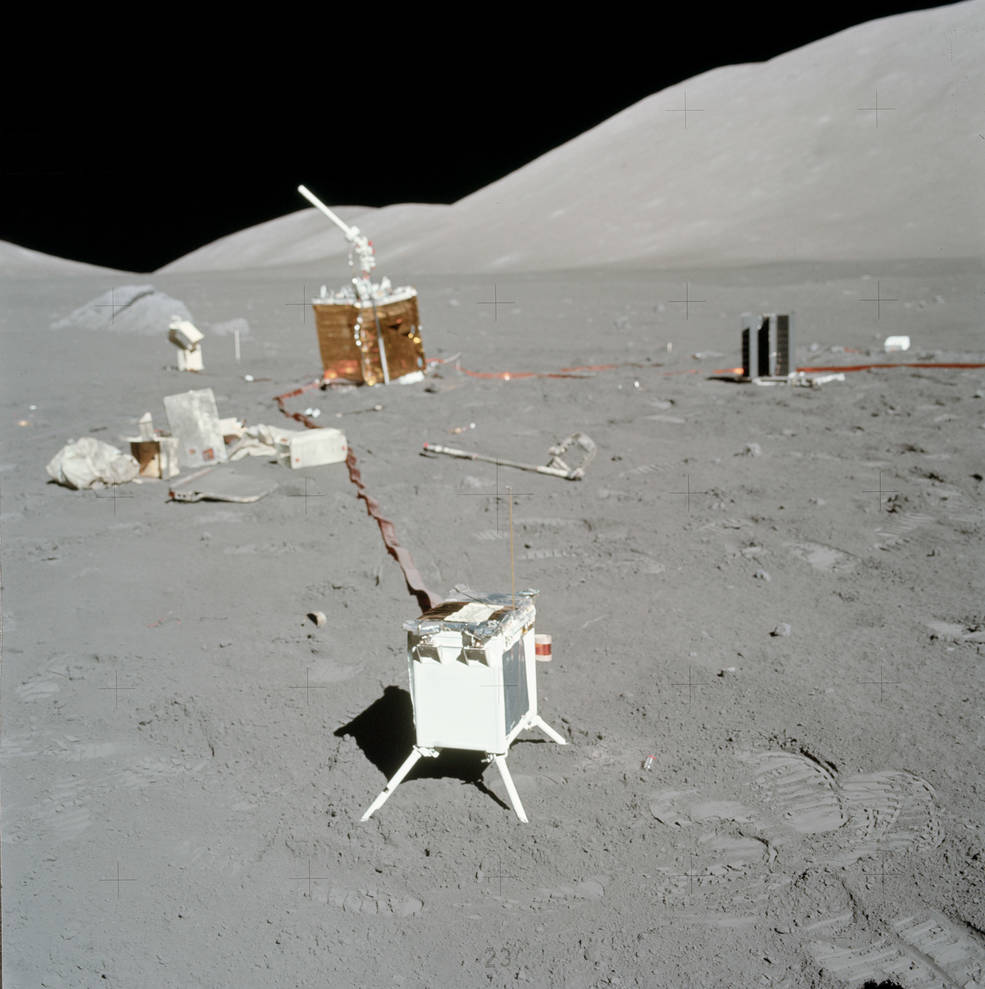
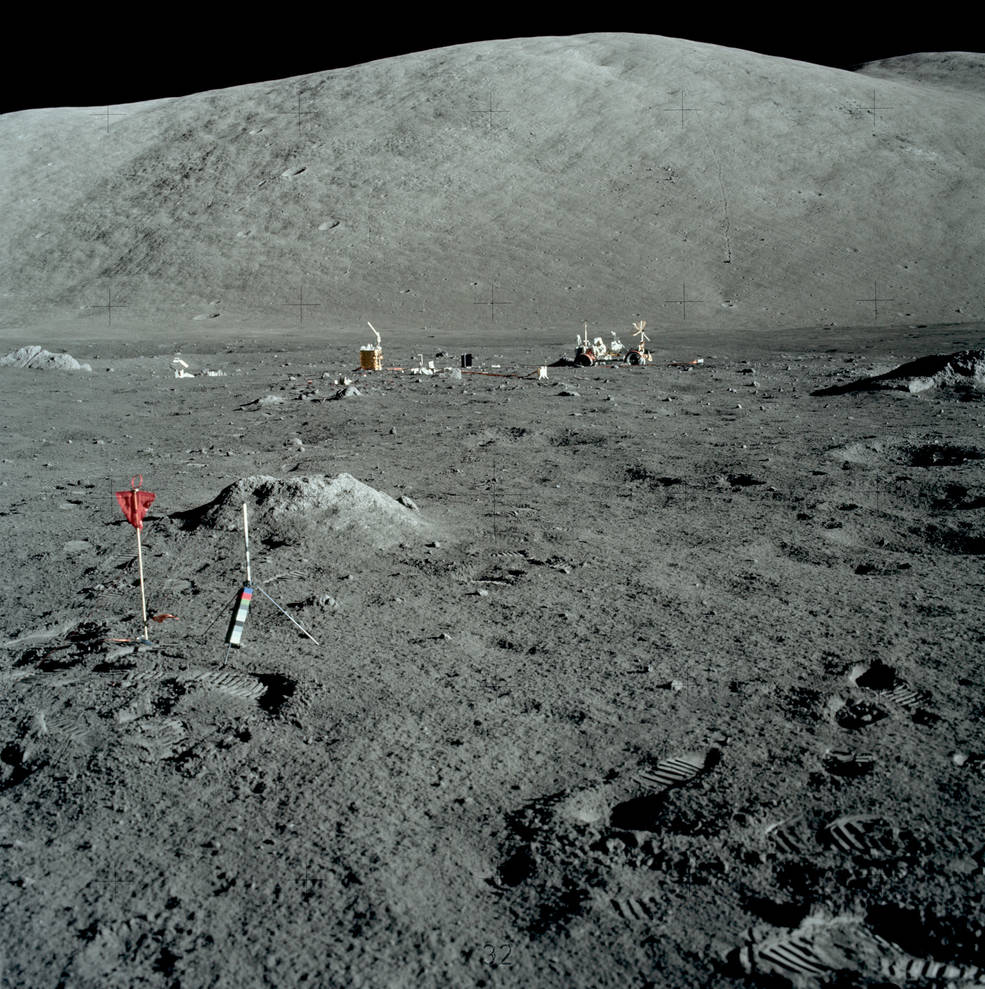
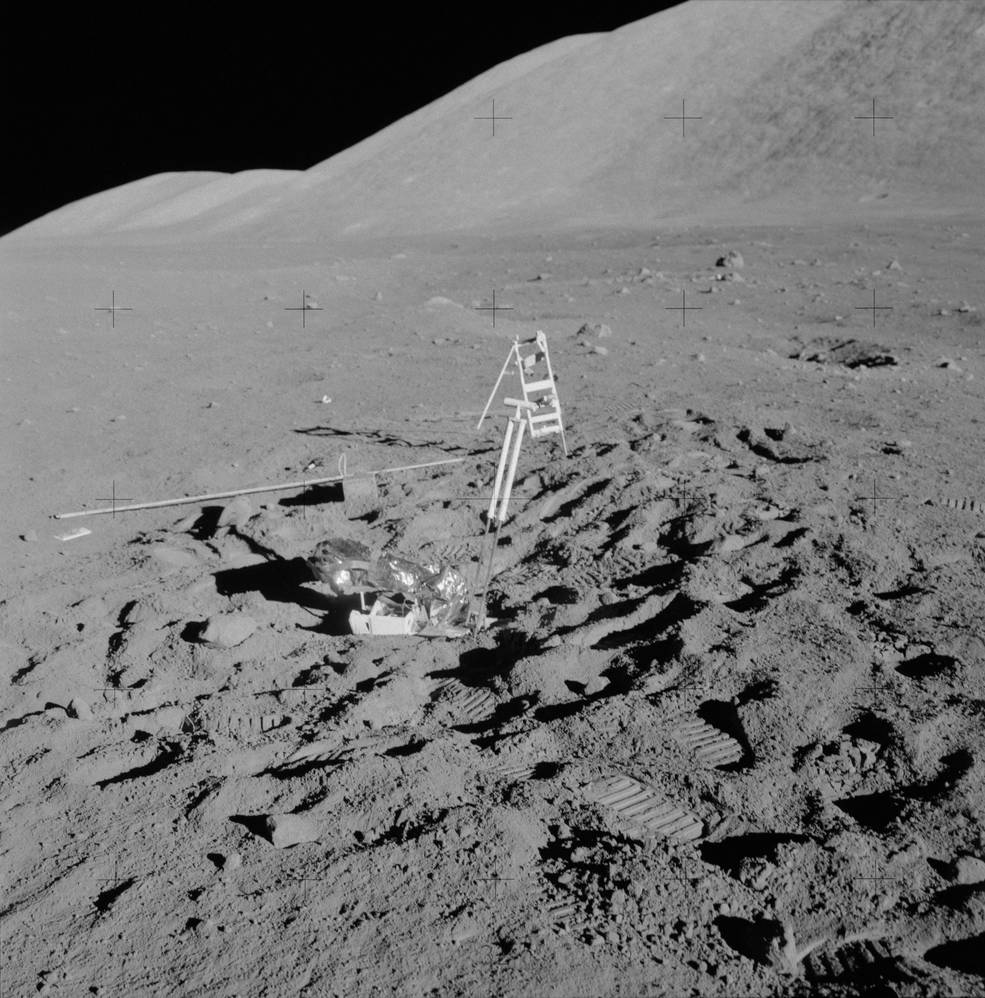
Left: The Lunar Ejecta and Meteorite experiment, foreground, and other components of the Apollo Lunar Surface Experiment Package (ALSEP). Middle: An overall view of the ALSEP site. Right: Photograph of the deep core sample site.
Schmitt deployed the cosmic ray experiment (later retrieved on the third spacewalk). Then he and Cernan began to unstow the ALSEP from the LM. Schmitt carried the instruments attached in a barbell configuration and chose an appropriate location about 600 feet west-northwest of the LM. Cernan inadvertently knocked off the Rover’s right rear fender with a hammer sticking out of his suit pocket and spent some time trying to tape it back on before driving out to join Schmitt at the ALSEP site. They deployed the Central Station, the power unit, and the various instruments. Cernan drilled the holes for the heat flow experiment and for a deep core sample, meeting occasional stiff resistance from layers of the lunar surface. He had more difficulty removing the core sample, putting them behind the timeline. Once they finished the work at the ALSEP site, they loaded their gear onto the Rover, Schmitt walked back to the LM with the core samples and Cernan drove the Rover to a site to the southeast of the LM to set up the Surface Electrical Properties (SEP) experiment.

Panoramic view of Station 1 during the first Apollo 17 surface excursion.
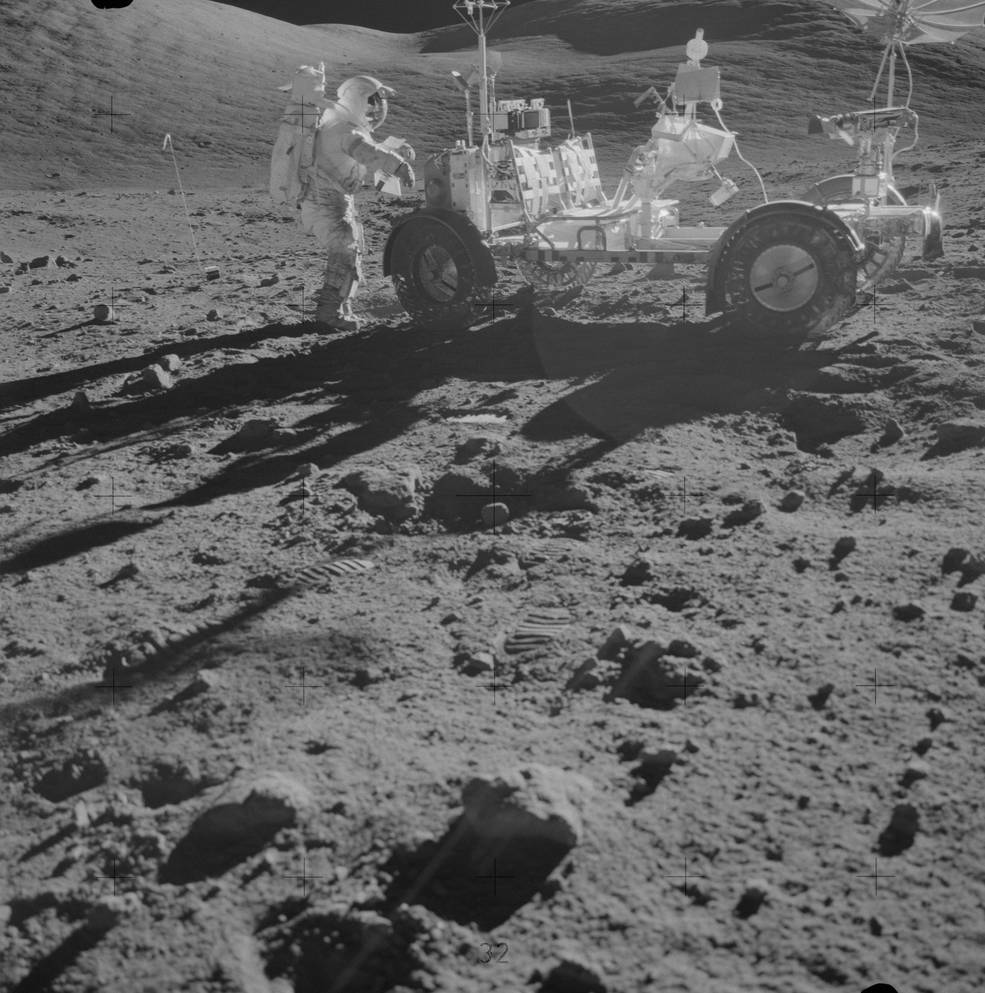
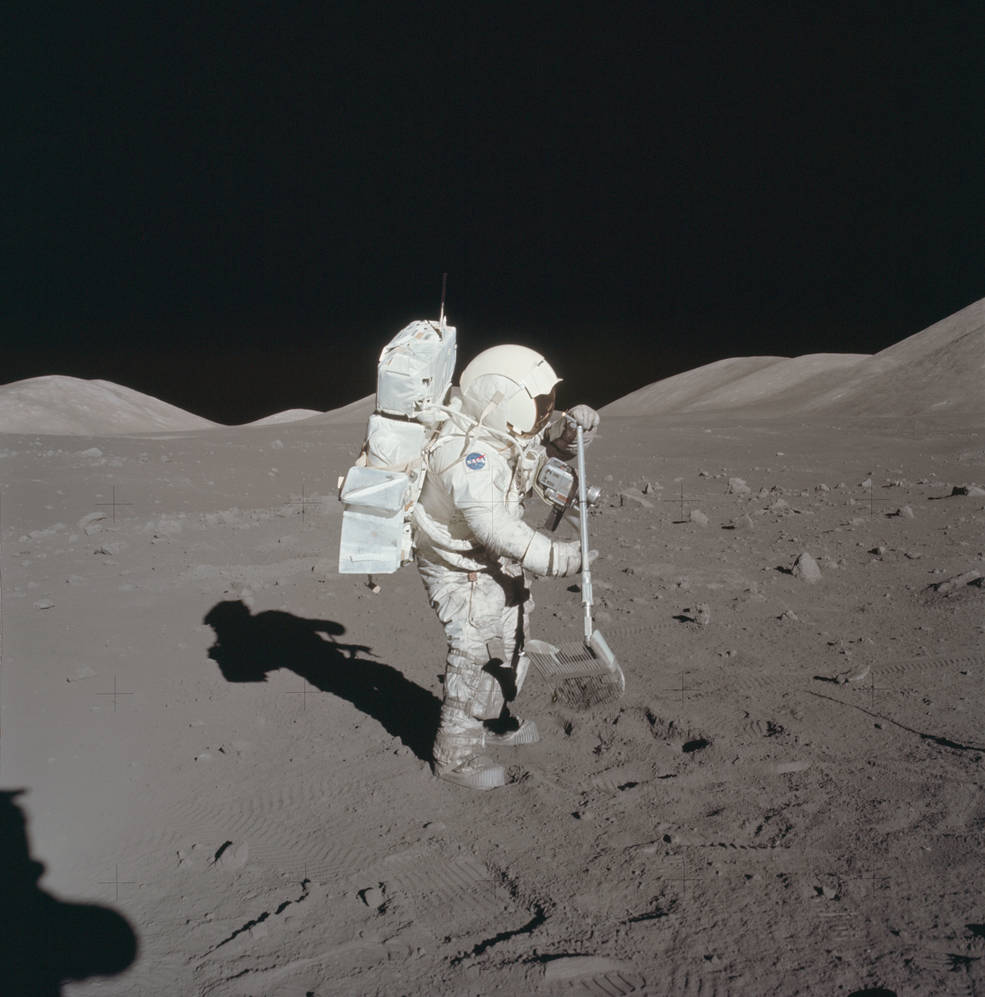
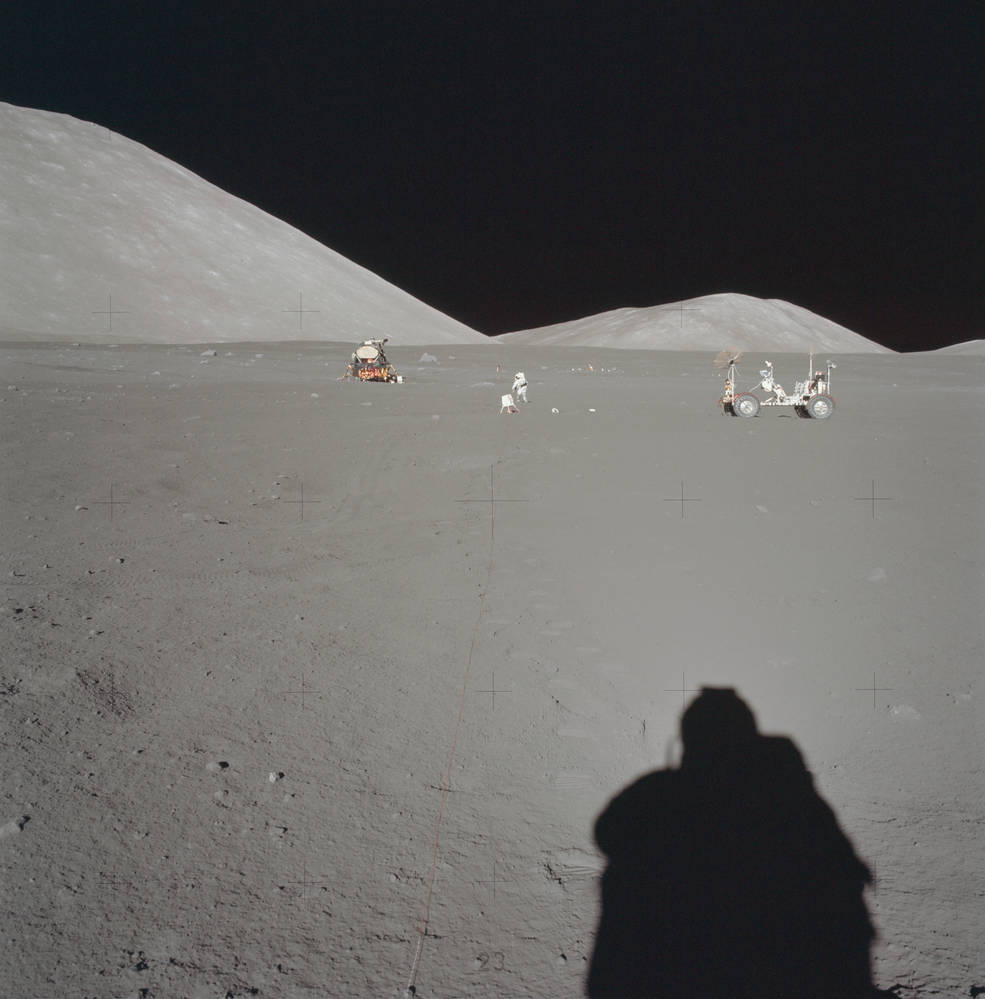
Left: Apollo 17 astronaut Eugene A. Cernan works near the Lunar Roving Vehicle at Station 1, with one of the explosive charges for the Lunar Seismic Profiling Experiment seen at left. Middle: Apollo 17 astronaut Harrison H. “Jack” Schmitt collects lunar samples with a rake at Station 1. Right: View during the deployment of the transmitter antenna of the Surface Electrical Properties experiment, with Lunar Module Challenger, Schmitt, and the Lunar Roving Vehicle seen in the background.
They set off on their first traverse to Station 1, half a mile south of the LM. They parked the Rover about 150 meters from the rim of Steno Crater. Schmitt deployed one of the explosive charges for the Lunar Seismic Profiling Experiment (LSPE) while Cernan hammered a chunk from a boulder at the edge of a crater. On the way back to the LM, they deployed another LSPE charge. As they approached the SEP site, a rooster tail of lunar dust from the right rear wheel indicated that Cernan’s makeshift fender had fallen off the Rover. The loss of the fender exacerbated the pervasive lunar dust problem. At the SEP site, Cernan drove the Rover in a cross-shaped pattern and Schmitt used the wheel tracks to lay out the four arms of the experiment’s transmitter antenna. Schmitt walked back to the LM while Cernan drove the Rover, parking it between the LM and the American flag. The two packed up the samples they collected and the film cartridges, and spent considerable time dusting each other off. First Schmitt, then Cernan climbed up the ladder, made their way back inside the LM, closed the side hatch, and repressurized the cabin. Their first spacewalk had lasted 7 hours and 12 minutes, during which they drove the Rover two miles and collected nearly 32 pounds of samples. Cernan and Schmitt removed their spacesuits, debriefed the excursion with Mission Control, and ate a meal. Schmitt took several photographs out the LM window using a 500 mm lens of boulders that had rolled down North Massif. While the astronauts took their first sleep period on the Moon, controllers in MCC devised a plan to build a replacement for the missing Rover fender.
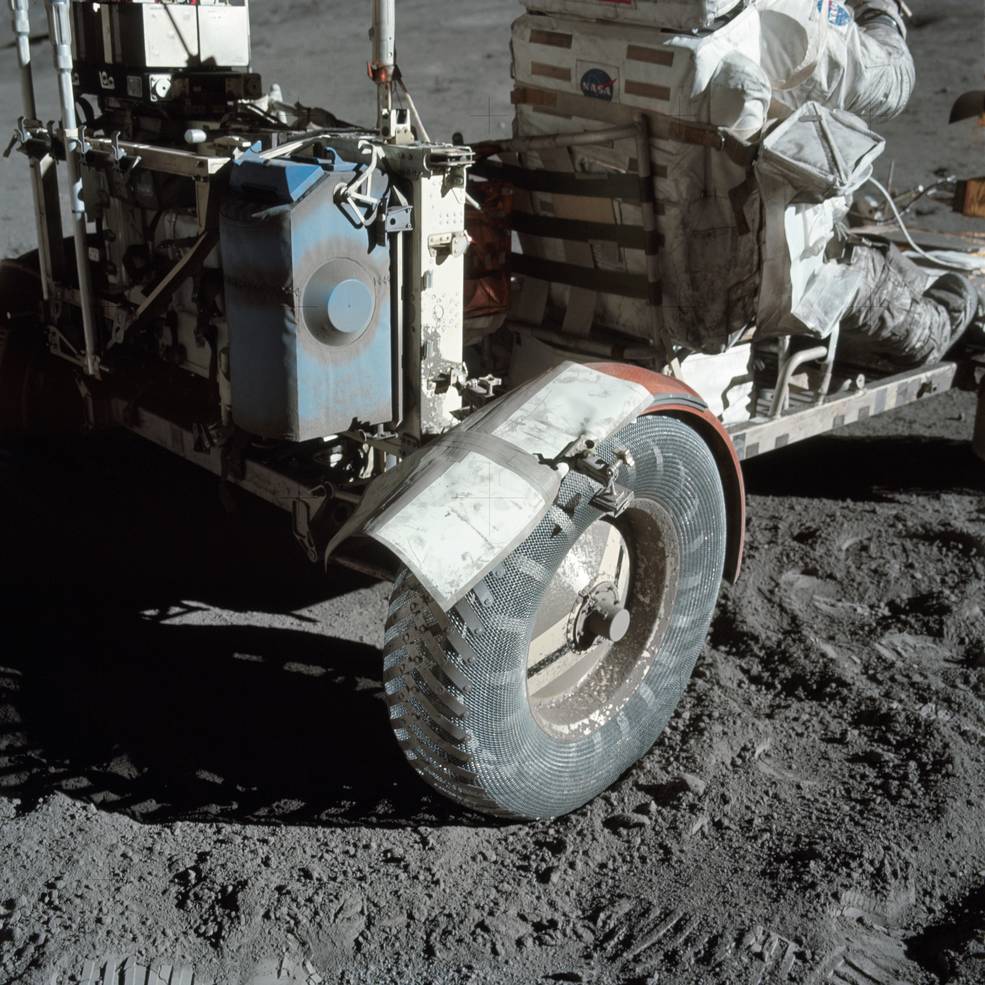
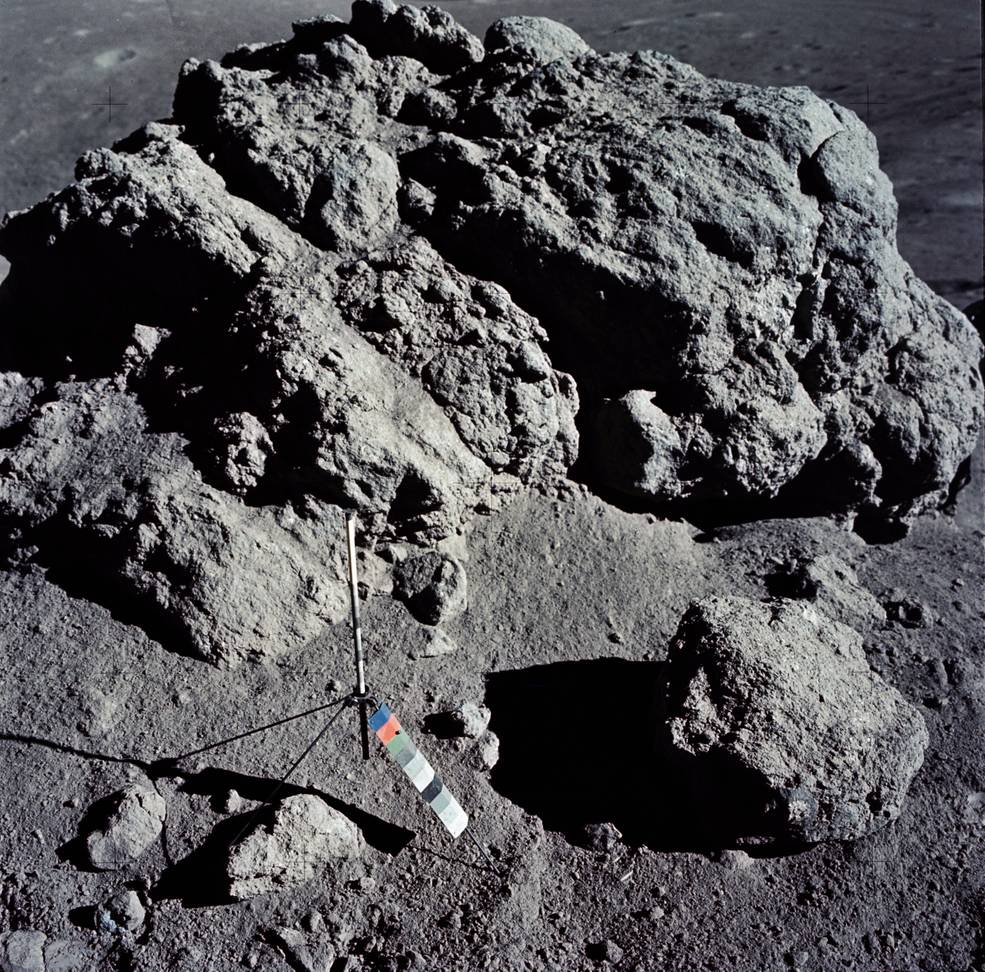
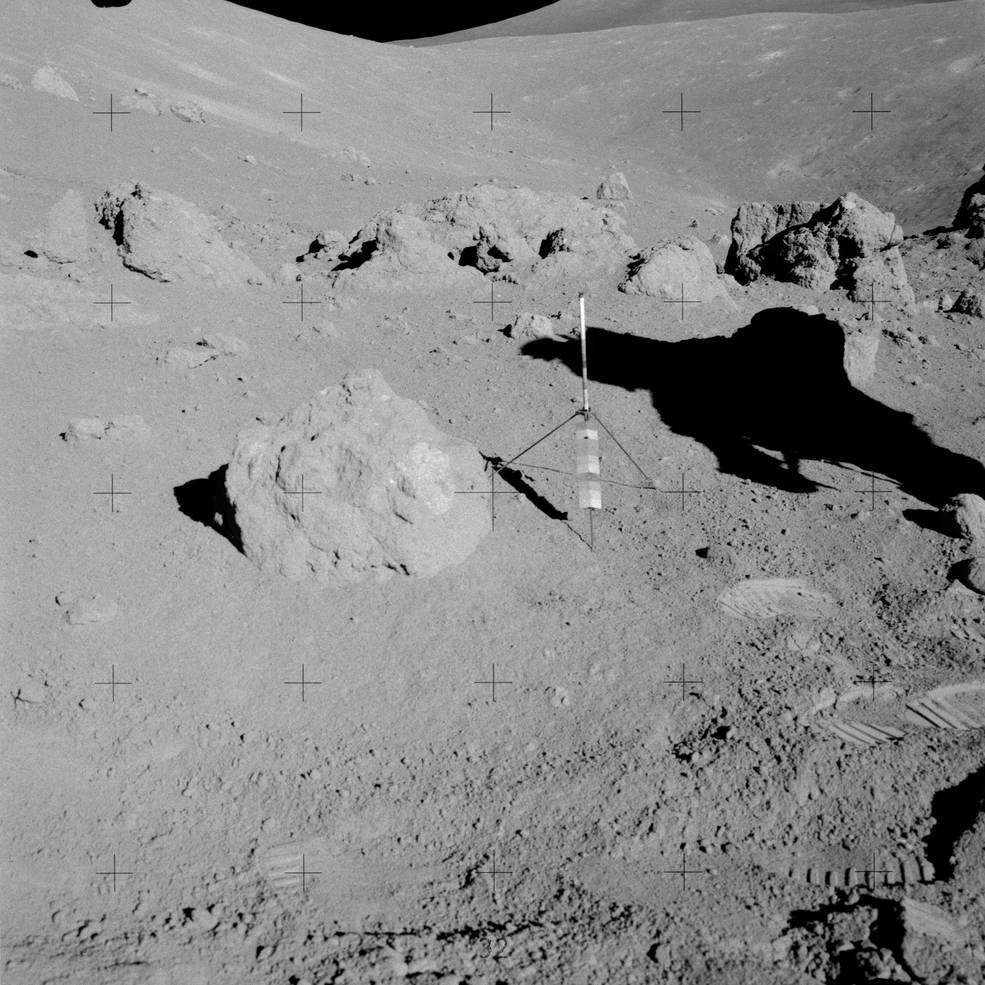
Left: Photograph of the makeshift Rover fender during the second surface excursion. Middle: Cernan and Schmitt sampled this rock in the Nansen depression at Station 2. Right: A sample from this rock at 4.6 billion years old is the oldest rock returned from the Moon.
The next morning, MCC awakened Cernan and Schmitt with Richard Wagner’s “Ride of the Valkyries,” chosen by capcom Parker. Following breakfast, astronaut Young, backup Apollo 17 commander and a veteran of Rover fender repairs on Apollo 16, read up a procedure to Cernan and Schmitt on how to use onboard maps to create a new fender and minimize the dust problem during drives. They ate breakfast and suited up, ready for their second excursion. They depressurized the LM, and as on the previous day, Cernan went down the ladder first, followed by Schmitt. Once on the surface, they packed up the Rover for the excursion and Cernan implemented the makeshift fender fix. Their first short drive took them back to the SEP to check on its status and use the Rover to calibrate the transmitter antenna. They then headed west for the drive to their next stop, Station 2 near South Massif. Shortly after they passed the ALSEP site on their right, Cernan stopped the Rover and Schmitt deposited another charge for the LSPE. They continued the drive west, skirting the southern rim of 600-meter-wide Camelot Crater, finding many boulders for sampling later in the traverse, and taking samples at predetermined points along the way to Station 2. Halfway through the drive, they turned southwest and climbed the Scarp at the foot of South Massif. At the end of their 9.1 km trek, Cernan parked the Rover at Station 2 in a depression called Nansen that contained many boulders that had rolled down from the Massif. Cernan and Schmitt collected rock and soil samples, including from under a rock overhang not exposed to the solar wind, to see if that had any effect on the soil’s composition. Chips from a boulder they sampled turned out to be, at 4.6 billion years, the oldest samples brought back from the Moon.
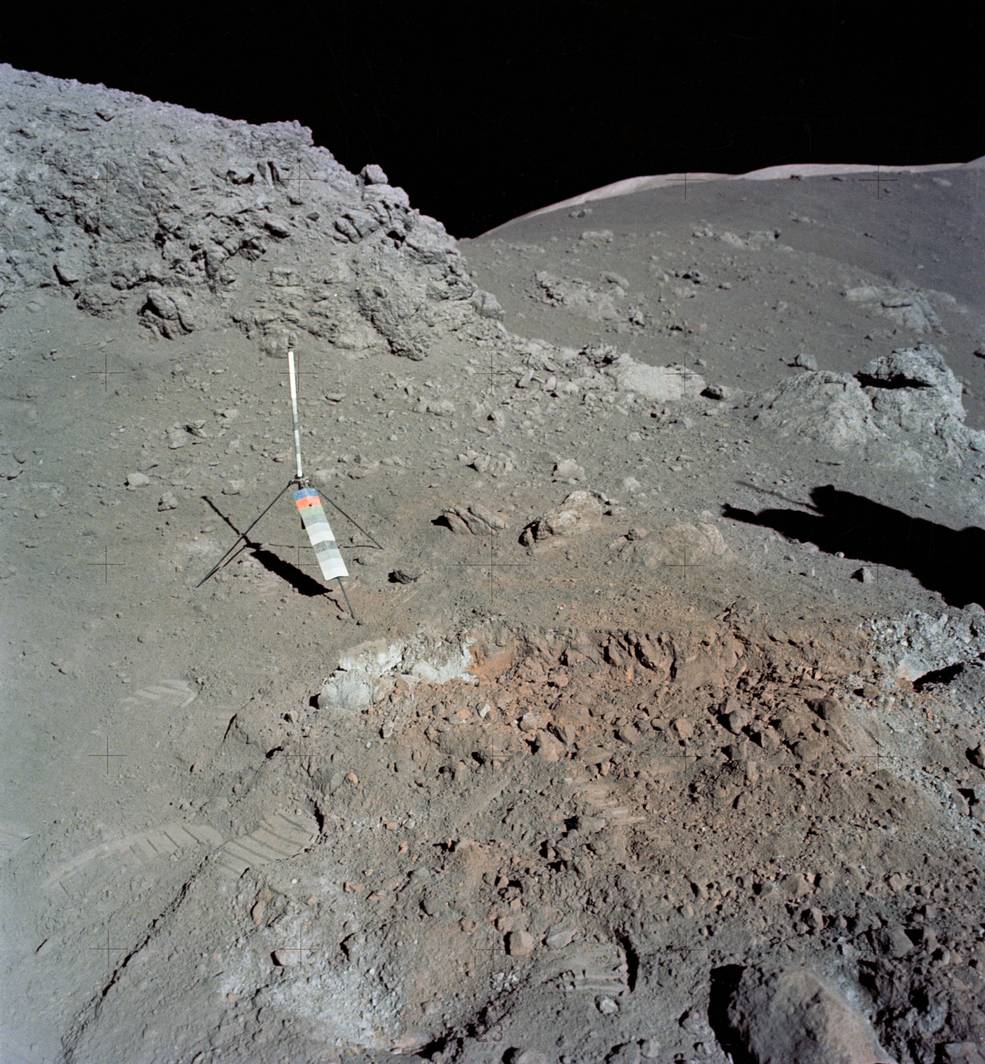
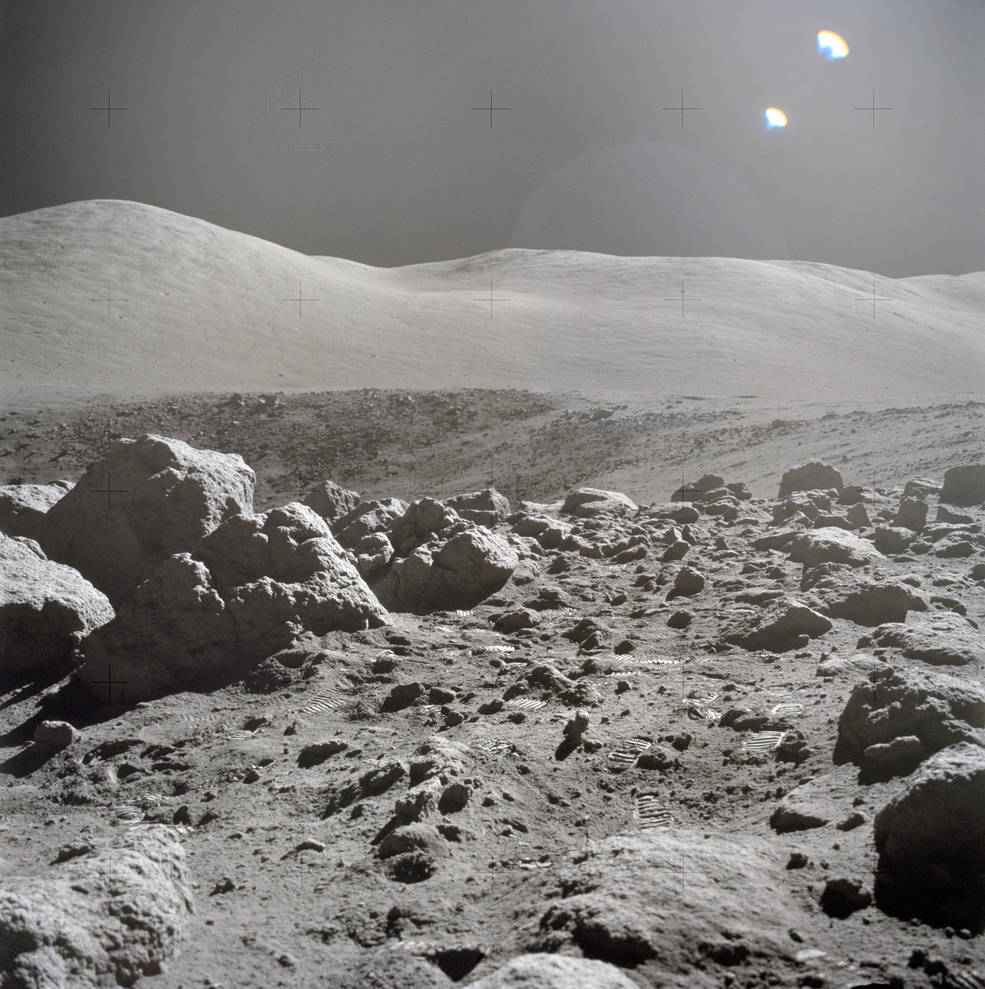
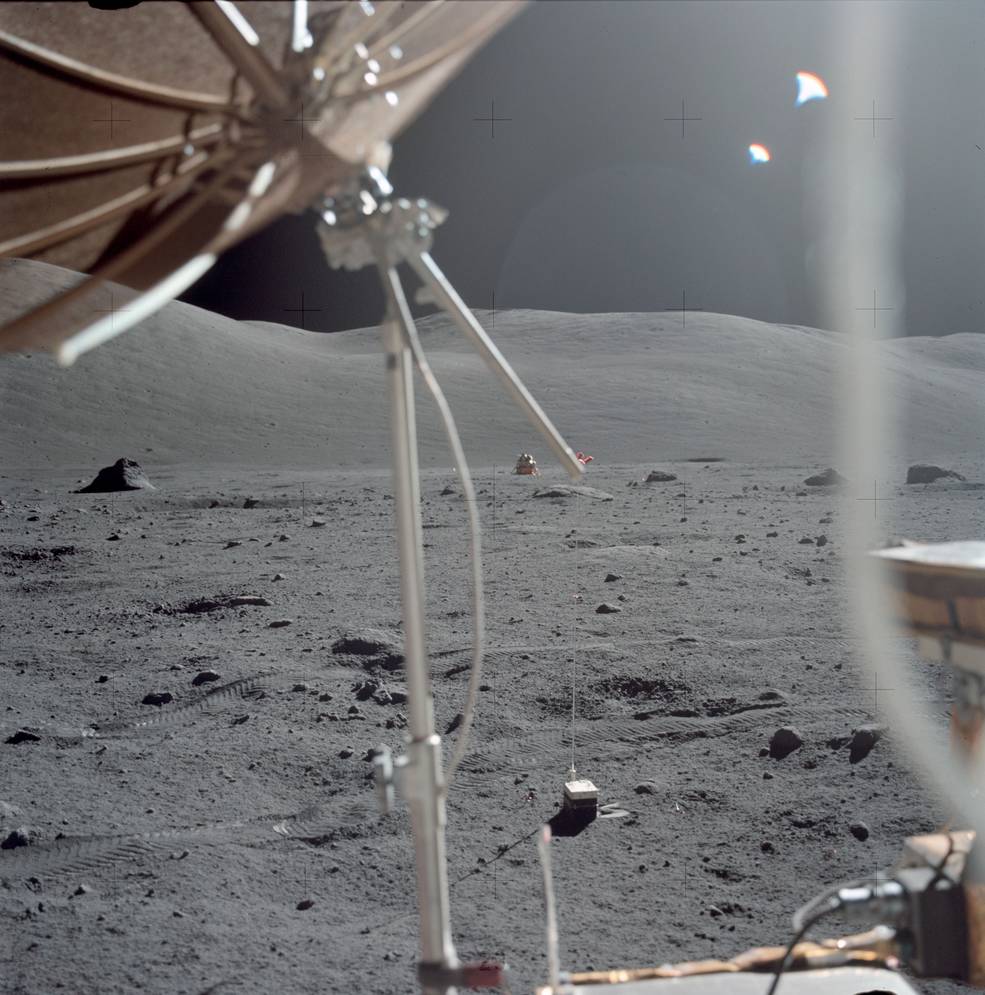
Left: Orange soil near Shorty Crater at Station 4. Middle: Station 5 amid the boulders on the rim of Camelot Crater. Right: The Lunar Module Challenger in the distance as Cernan and Schmitt returned for their second lunar surface excursion.
Having packed up the Rover, they headed off to Station 3, at first retracing their tracks to the northeast, then turning more northward toward the crater Lara. Cernan took a core sample and Schmitt collected samples of his own choosing, including from a trench he dug. The packed their samples and headed northeast to Station 4 and the 330-foot diameter crater Shorty, about 1.5 miles away. Because they purposely took extra time at Station 2, Mission Control deleted most of the tasks at Station 4. But as they began exploring the site, Schmitt called out in surprise, “There is orange soil!!” Cernan walked over and confirmed it. They collected the highly unusual sample, and also took a core sample. Postflight analysis indicated the orange soil to be small spherical glass beads with a high titanium content. Cernan and Schmitt got back in the Rover and raced more or less east to Station 5 on the southwestern rim of 600-m wide Camelot crater, deploying a LSPE charge along the way. They parked the Rover among the blocks or boulders on the crater’s rim and collected samples from them, before they headed east back to the LM. During the 17-minute traverse back to Challenger, they deployed three more LSPE charges and stopped for 500-mm lens photography. Cernan dropped Schmitt off at the ALSEP for some housekeeping chores and drove the Rover back to the LM, and Schmitt followed shortly on foot. They packed up the 75 pounds of samples they collected during this traverse and took them back up the LM’s ladder. They spent a few minutes dusting each other off before heading up the ladder, entering the LM, and closing the hatch. They repressurized the cabin to end the second lunar traverse after a record-breaking 7 hours and 37 minutes. As after their first spacewalk, Cernan and Schmitt removed their spacesuits, debriefed their excursion with Mission Control, ate dinner, and went to sleep.
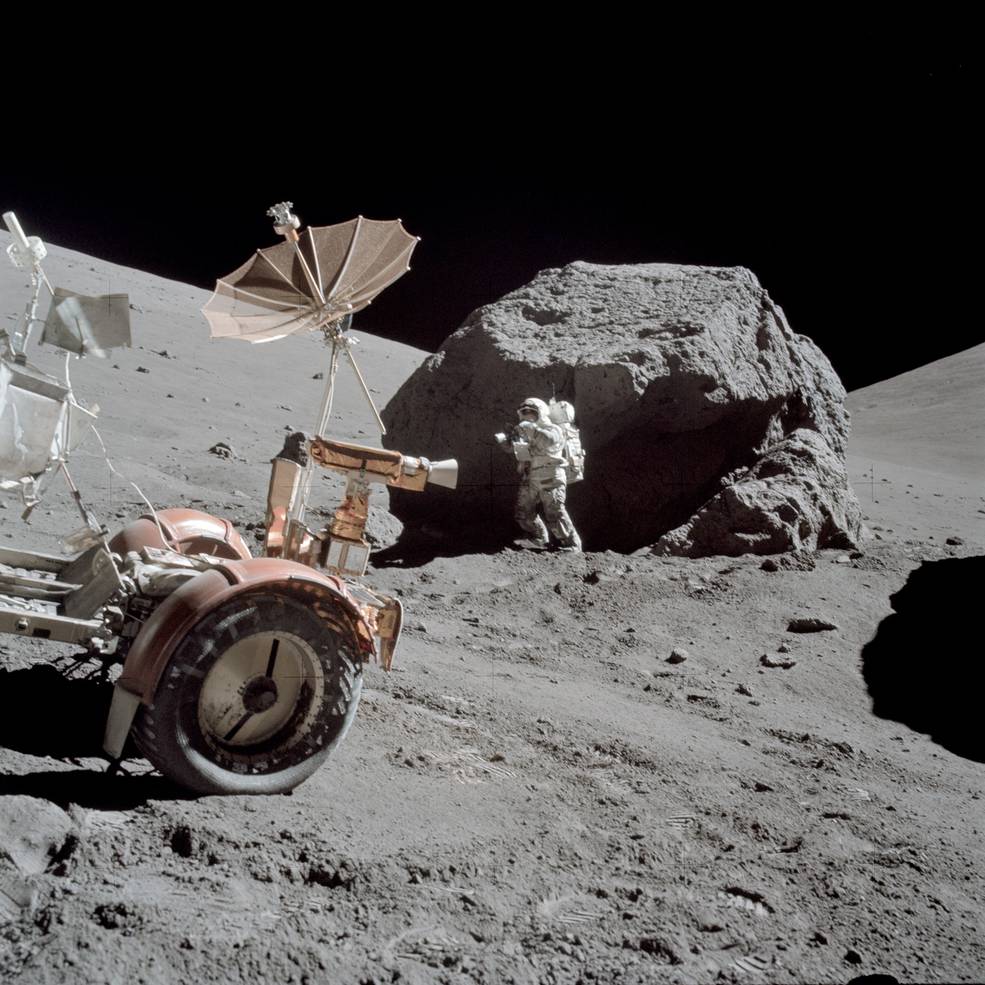
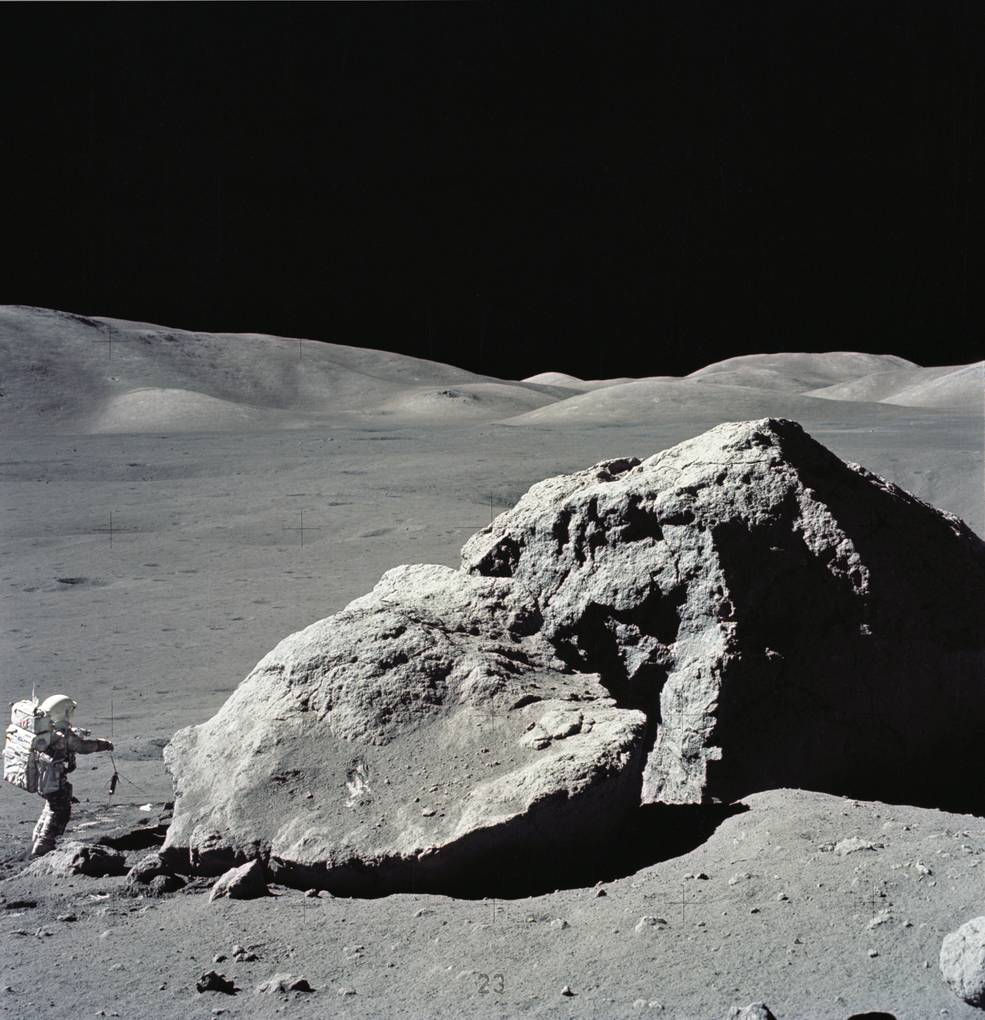
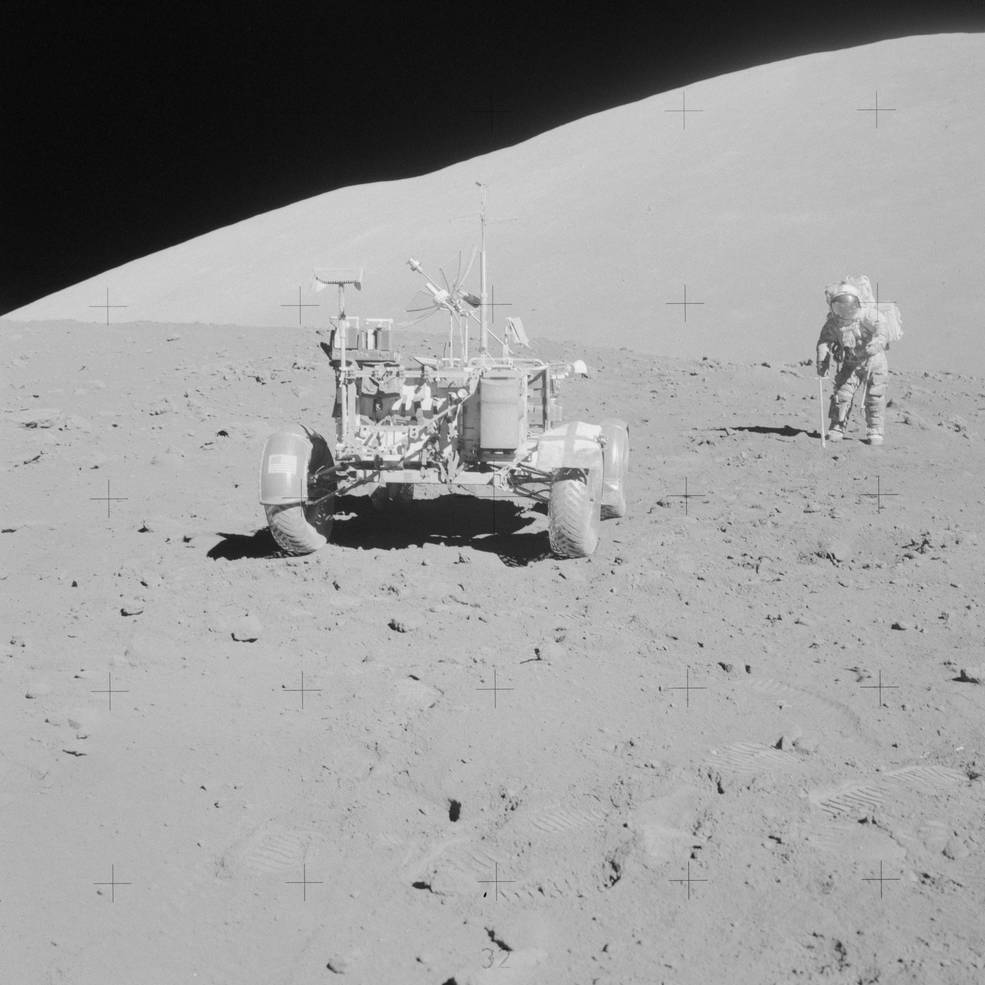
Left: During the third lunar surface excursion, Apollo 17 astronaut Harrison H. “Jack” Schmitt takes photographs in front of Split Rock. Middle: Schmitt takes samples from Split Rock. Right: Apollo 17 astronaut Eugene A. Cernan takes a core sample.
Mission Control let Cernan and Schmitt sleep an extra hour before waking them with the Texas A&M University War Hymn “E Pluribus Gig’em,” chosen by Gold Team Flight Director Griffin, a Texas A&M graduate. As on the previous two days, Cernan and Schmitt ate breakfast, donned their suits, depressurized the LM’s cabin, and climbed the ladder down to the surface, Cernan followed by Schmitt. Schmitt retrieved and stowed the cosmic ray experiment. They loaded up the Rover, made a brief stop at the SEP transmitter and then headed north toward a house-sized boulder known as Turning Point Rock, from where they turned to the northeast to reach Station 6 near North Massif. The main attraction there involved the five fragments of a large boulder named Split Rock that long ago tumbled down from North Massif. About 250 feet above the plain below, Cernan parked the Rover on a 20-degree slope, prompting him to report, “You can’t believe how tough it is getting around this Rover, on this slope!!” They collected a sample from a north facing overhang of the boulder, to gather soil that had not been exposed to the solar wind, and chipped samples from several of the boulder fragments. Cernan took a core sample before they packed up the Rover and headed east to Station 7, a short downslope drive away where during a brief stop they sampled another large boulder. From there, they drove further east to Station 8 at the base of the Sculptured Hills, where they collected rock and soil samples including from a trench that Schmitt dug.
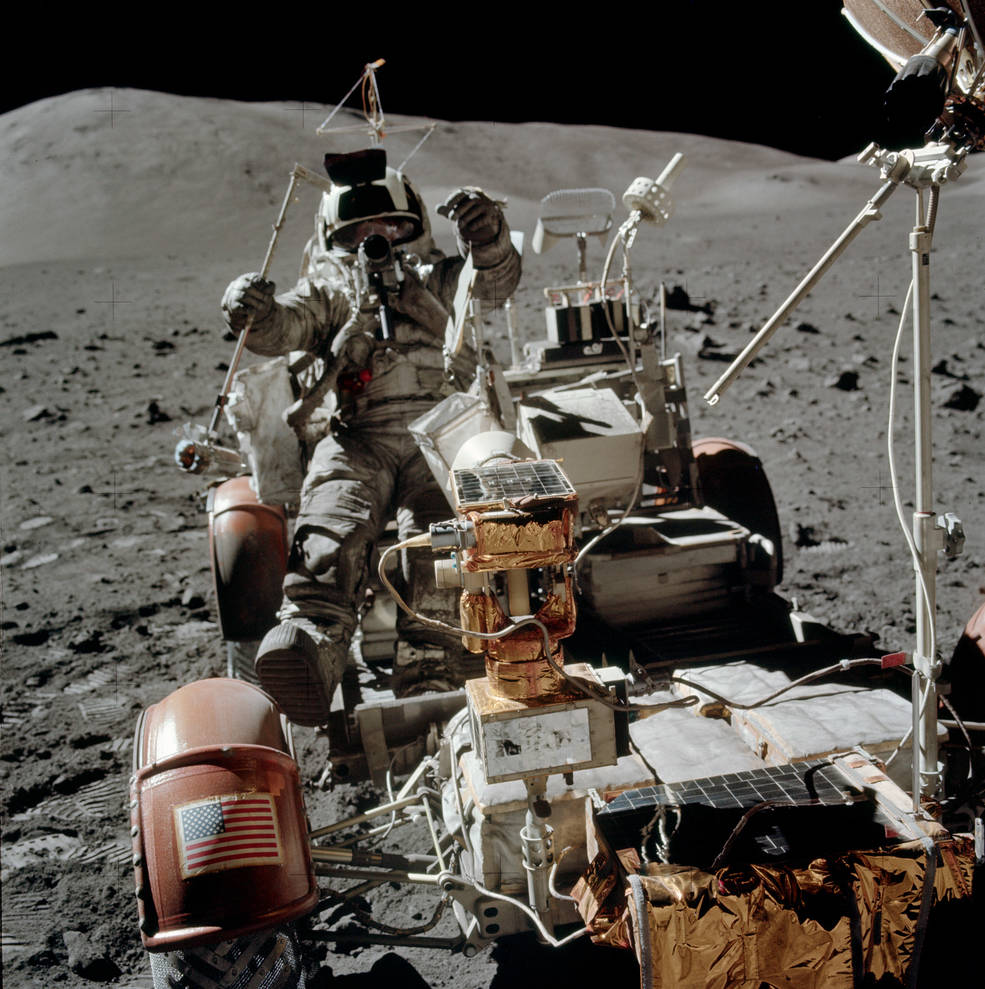
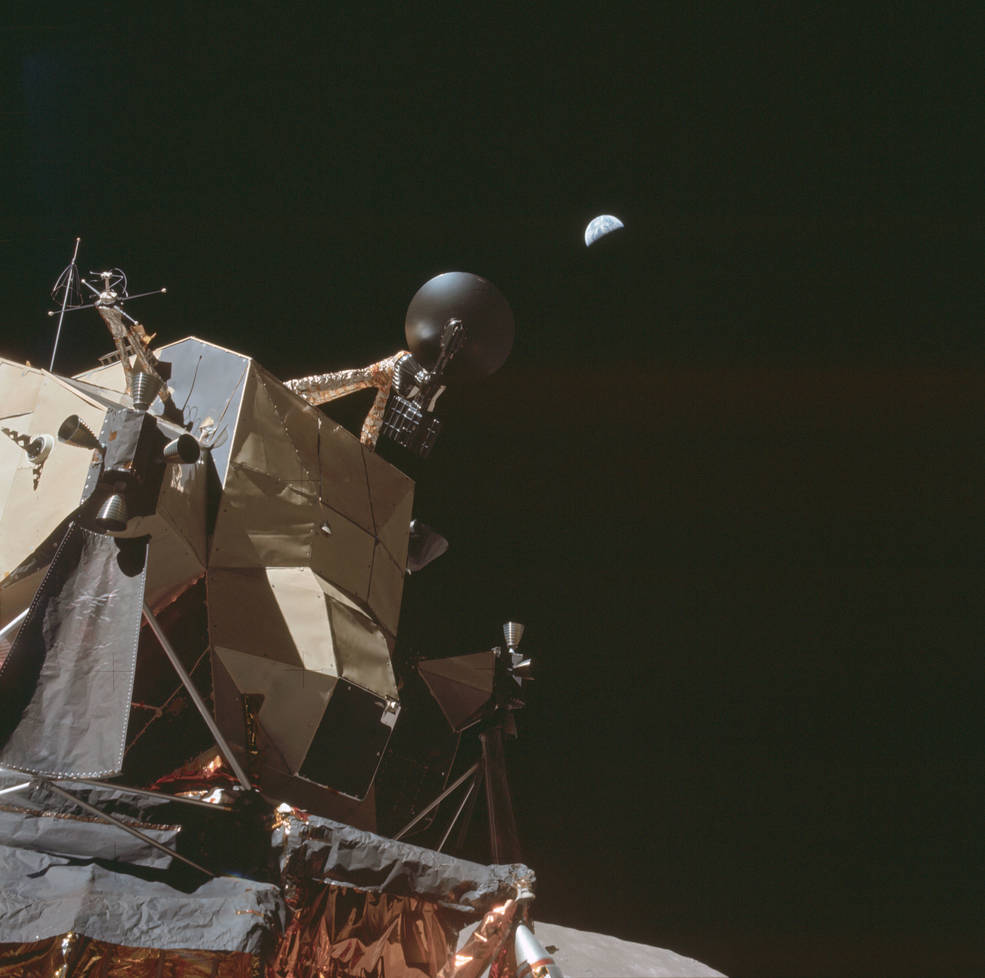
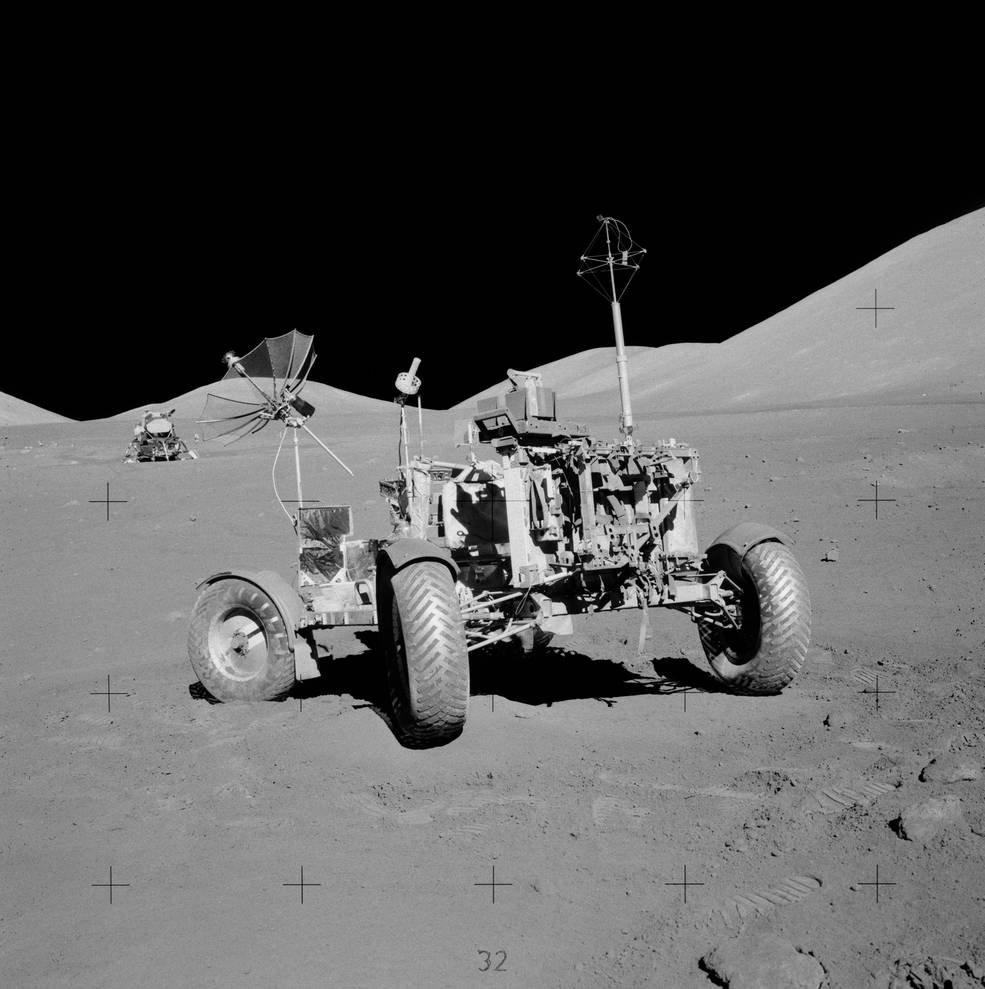
Left: Apollo 17 astronaut Harrison H. “Jack” Schmitt hops back onto the Lunar Rover. Middle: Earth above the Lunar Module Challenger. Right: The Lunar Rover parked in its final position to televise the lift off of Apollo 17 from the Moon.
Less than an hour later, Cernan and Schmitt drove southwest in the general direction back toward the LM to Station 9 at the Van Serg Crater. They collected rock and soil samples and a core sample from the area strewn with boulders, mostly likely the result of a meteorite impact, and deployed another LSPE charge. Due to timeline constraints, MCC decided to cancel the Station 10 stop, so Cernan and Schmitt headed directly back to the LM. Driving downhill, they set a lunar speed record of 18 km/h. They stopped along the way to collect a rock sample and deploy another LSPE charge. Near the LM, Schmitt collected a dark rock he spotted during the first spacewalk, at 8.1 kg the heaviest rock collected during Apollo 17. Later, NASA placed pieces of this rock on public display and remain the only lunar fragments that the public could touch. Cernan and Schmitt held a brief closeout ceremony, saluting students from around the world who had attended their launch. They displayed a rock composed of many fragments, noting how that symbolized the group of international students, and stated that a piece of the rock would be sent to museums in each of the students’ countries of origin. The rock became known as the Goodwill Rock, the most widely distributed rock from the Apollo program. Cernan thein uncovered the plaque commemorating their landing at Taurus-Littrow, mounted on the LM’s forward landing strut. While Schmitt walked out to the ALSEP site for some housekeeping chores, Cernan drove the Rover to its final resting place, dubbed the VIP site, about 158 meters from the LM, from where it televised their liftoff several hours later. As they did on their previous two spacewalks, Cernan and Schmitt packed up the 137 pounds of samples they collected on this excursion and hauled them up the ladder. Schmitt climbed up the ladder for the final time as Cernan handed him the last items. As Cernan prepared to climb the ladder, he radioed to MCC, “as I take man’s last step from the surface … – but we believe not too long into the future – I’d like to just (say) what I believe history will record. That America’s challenge of today has forged man’s destiny of tomorrow. And, as we leave the Moon at Taurus- Littrow, we leave as we came and, God willing, as we shall return, with peace and hope for all mankind.” He climbed up the ladder, entered the LM, and closed the hatch behind him. America’s first epoch of lunar surface exploration had come to an end.
To be continued…
John Uri
NASA Johnson Space Center



























